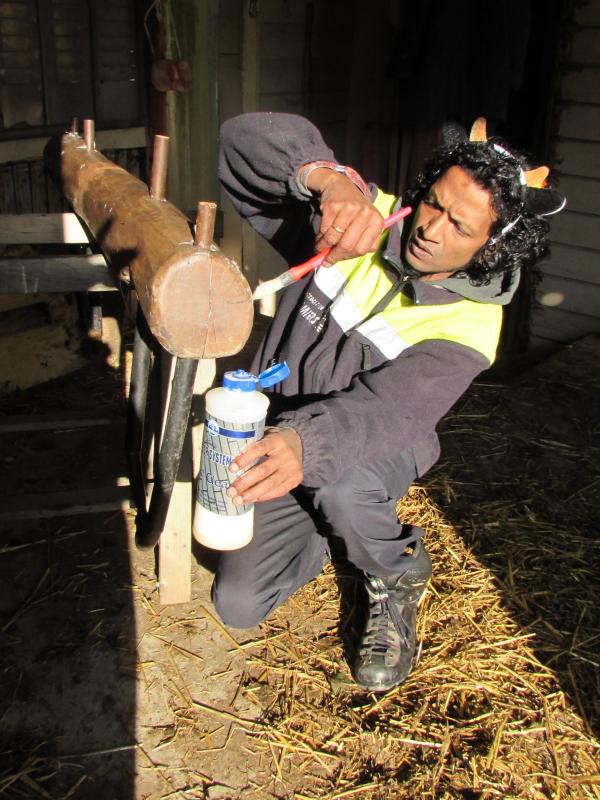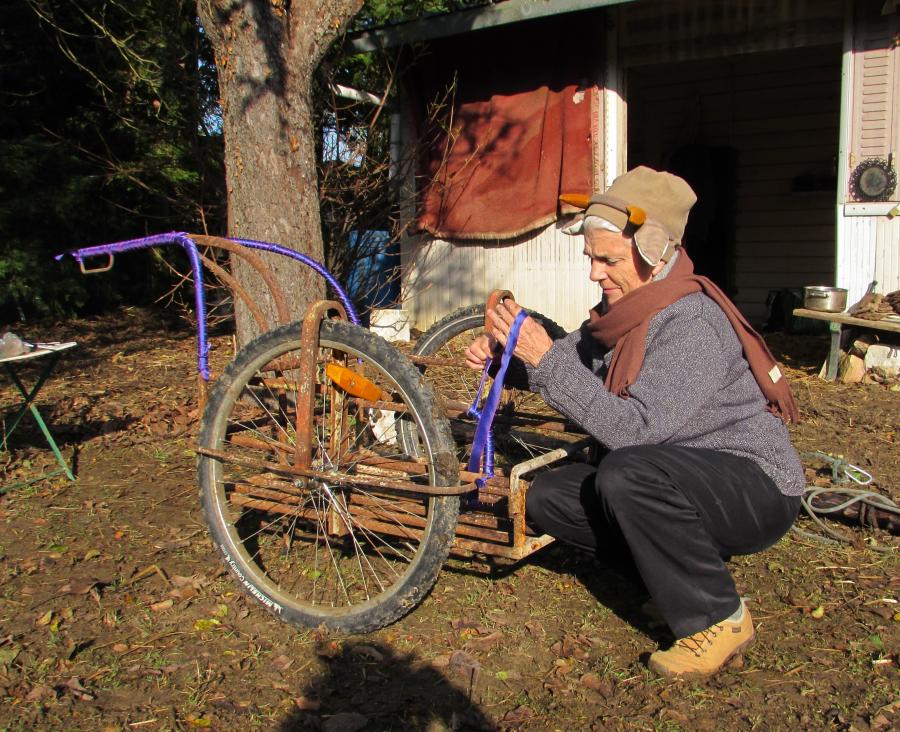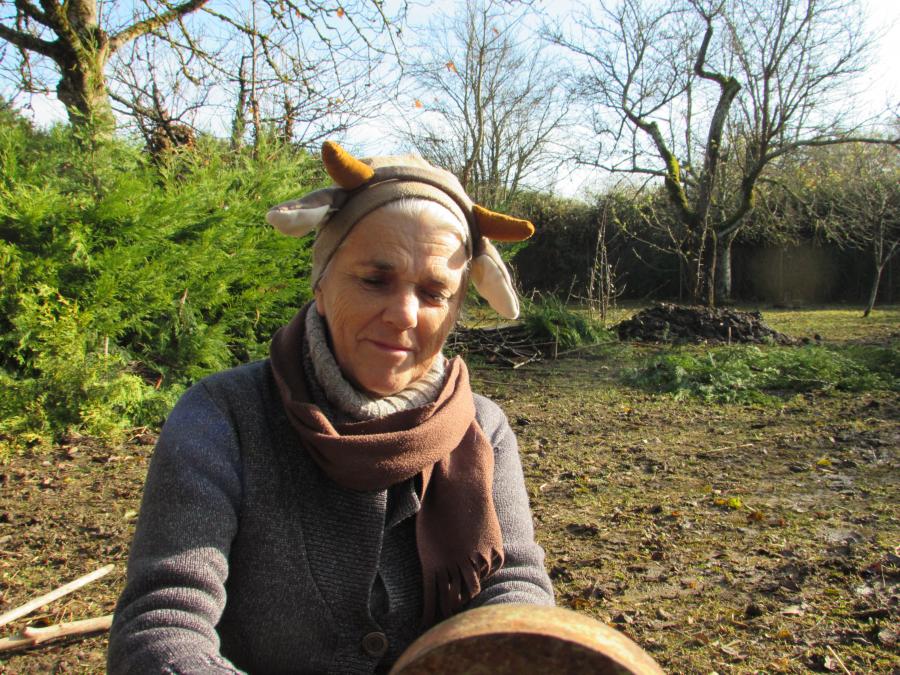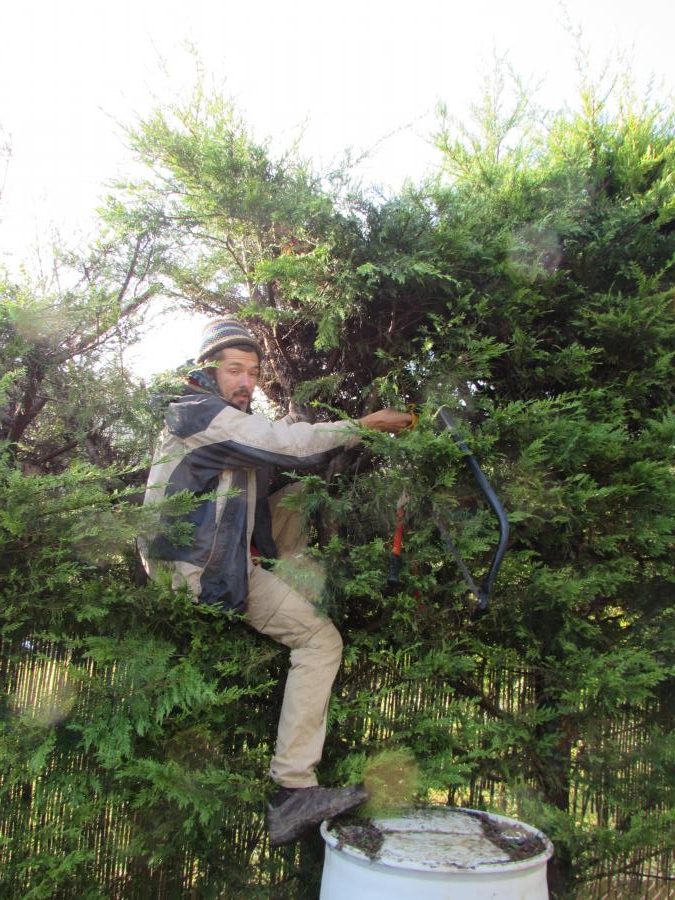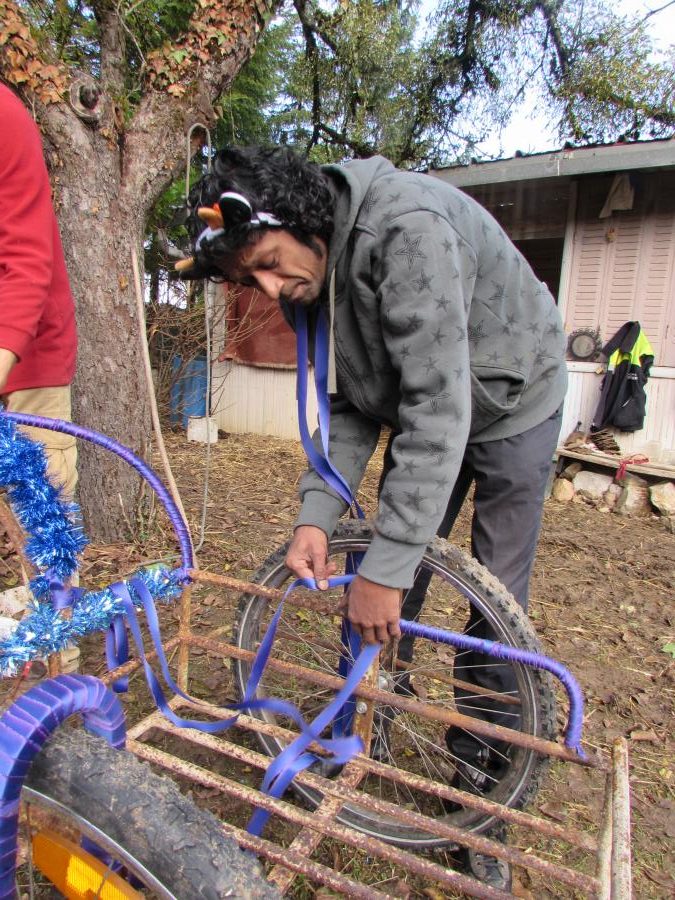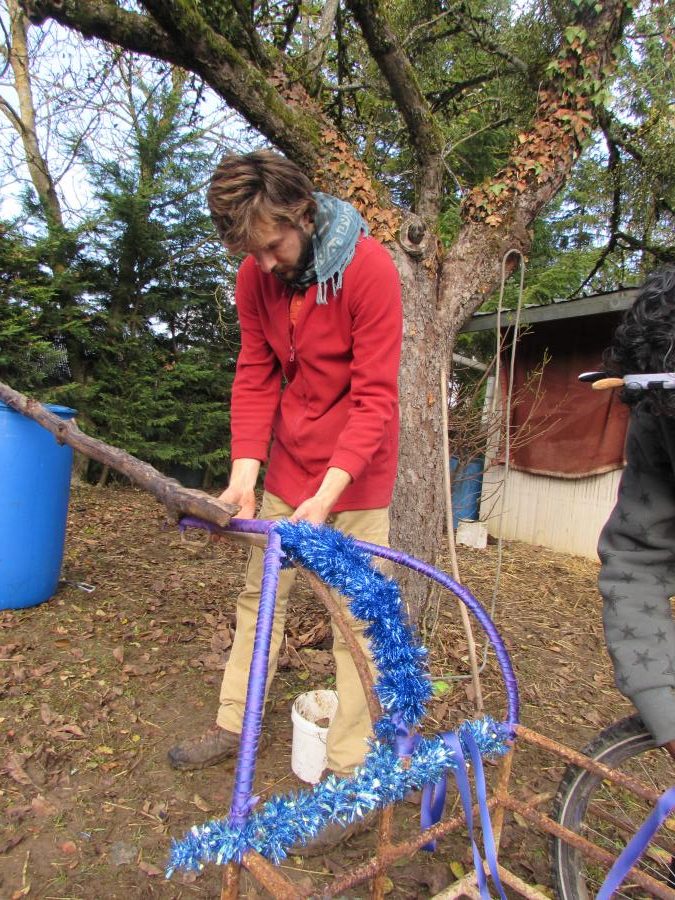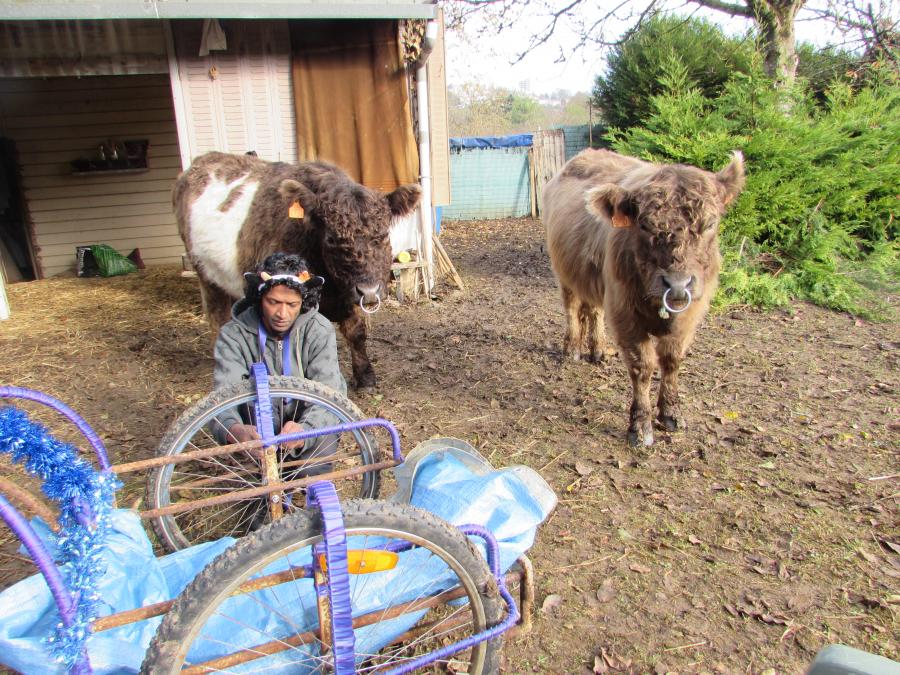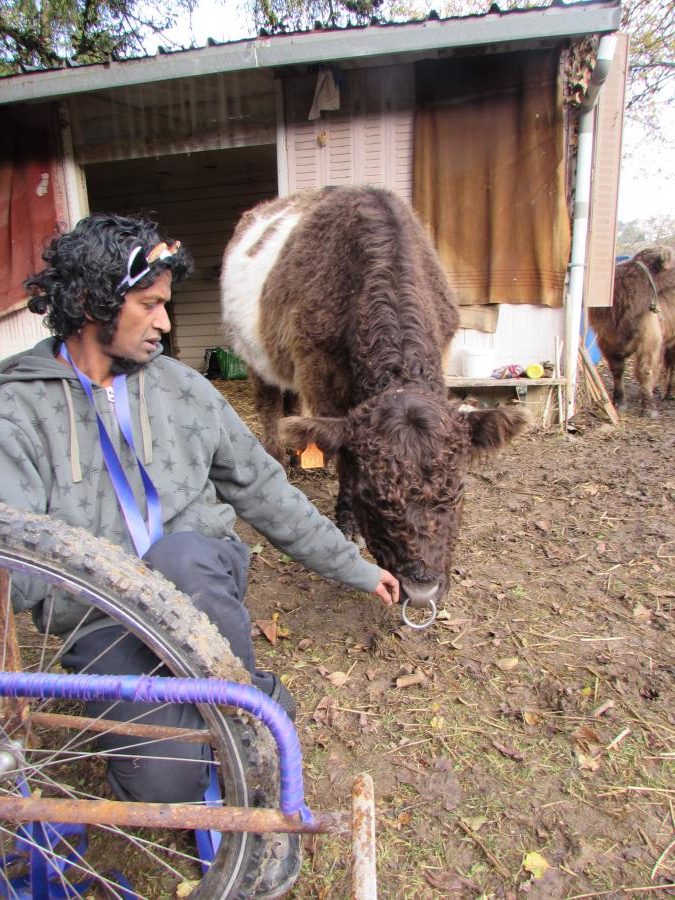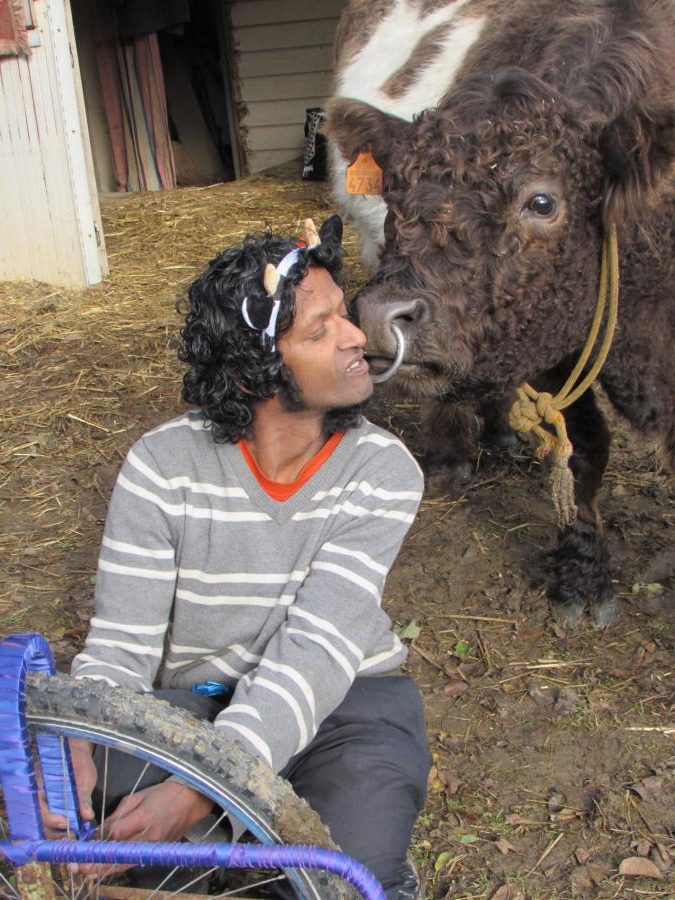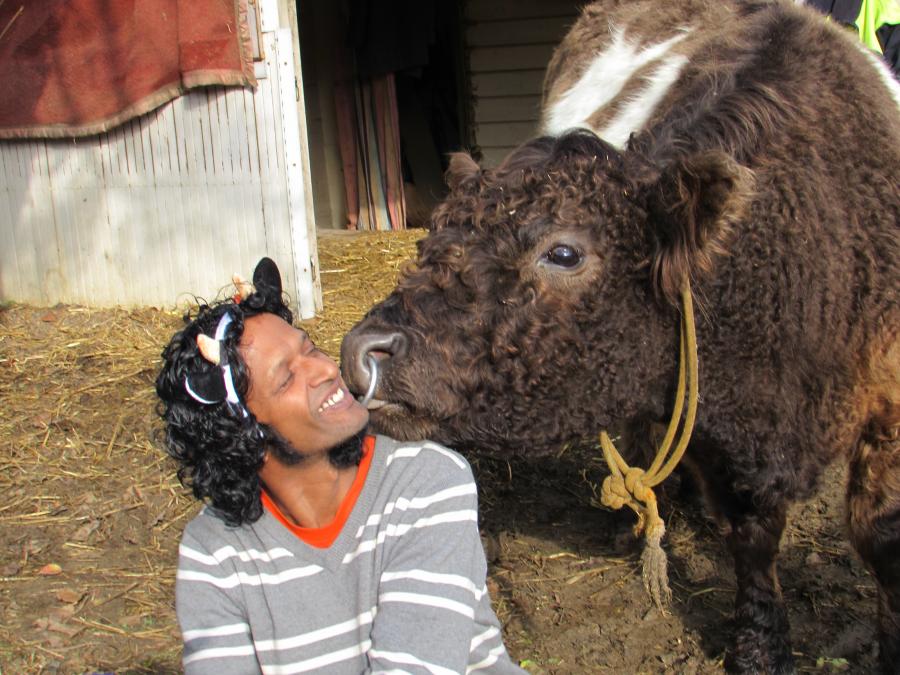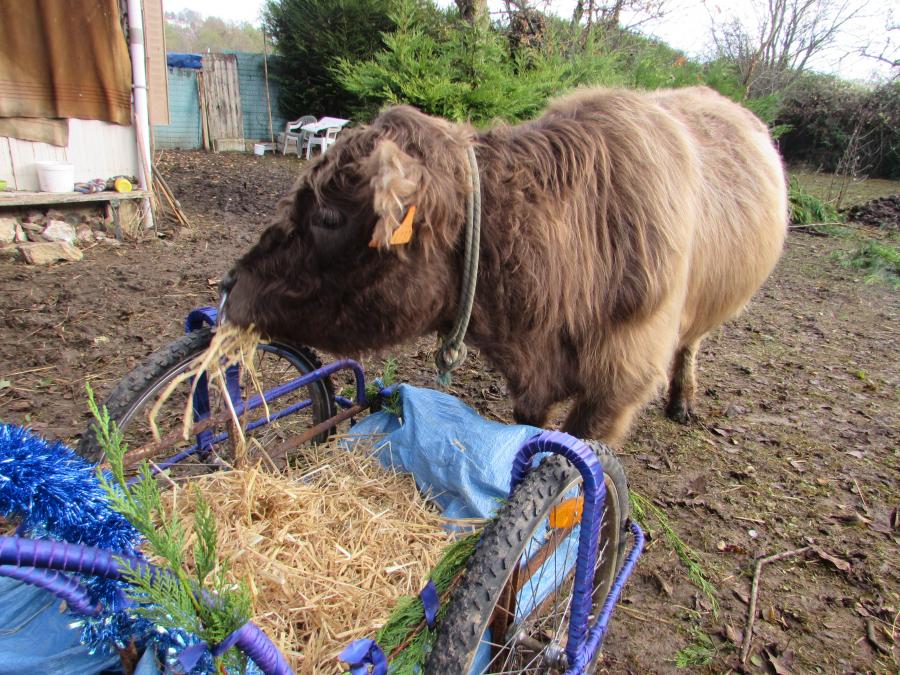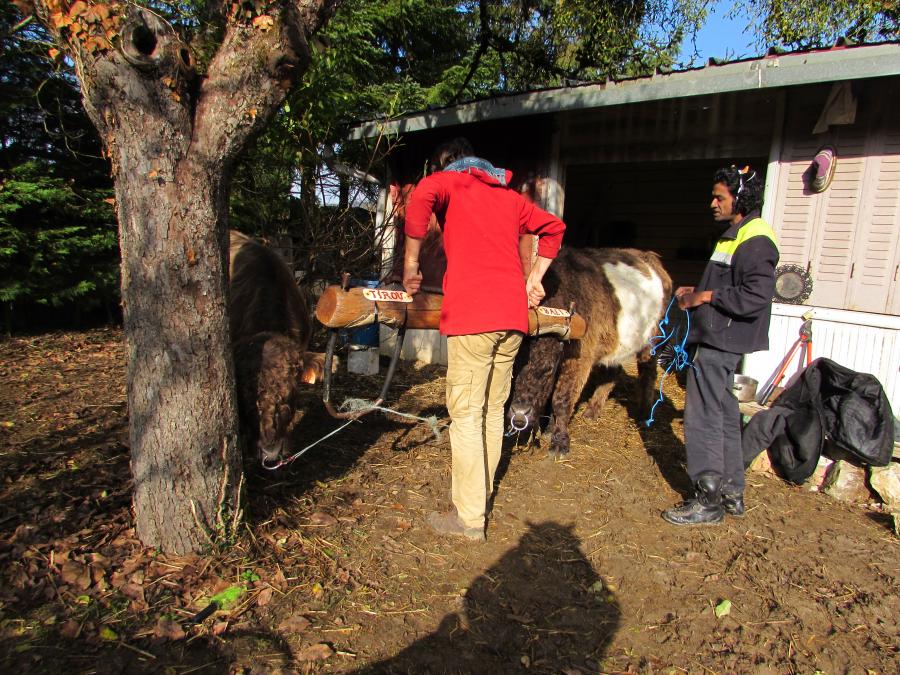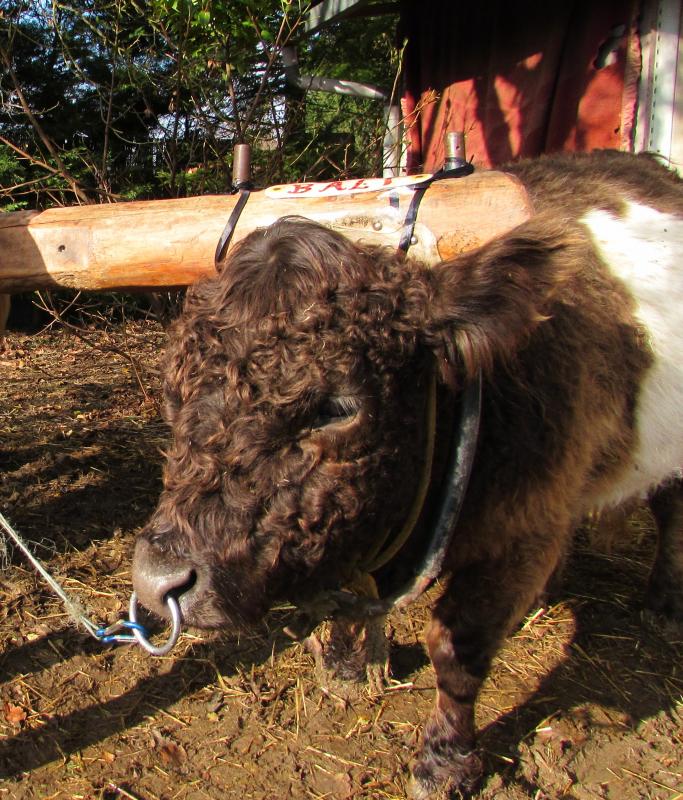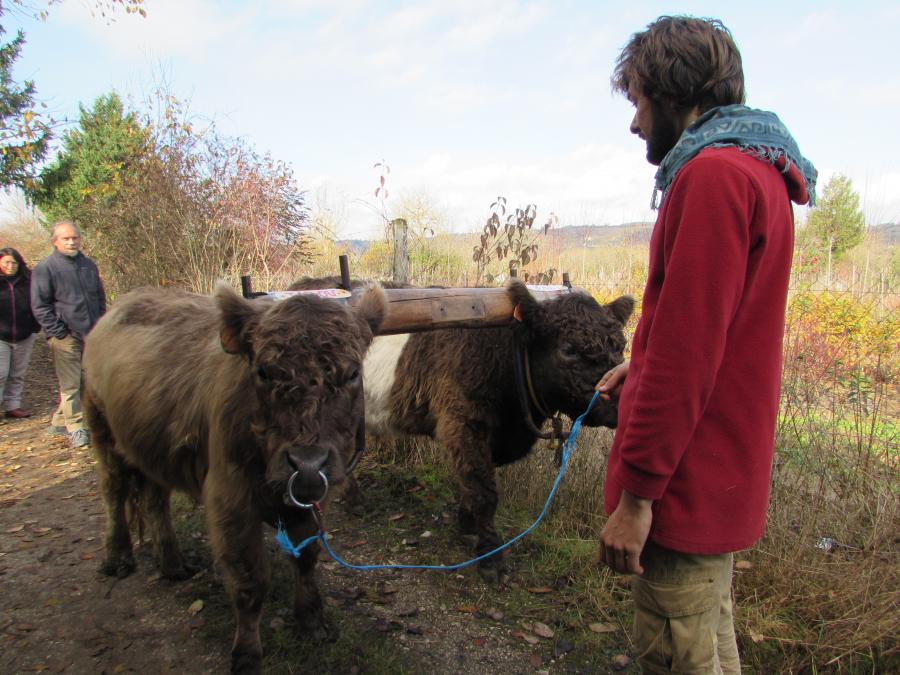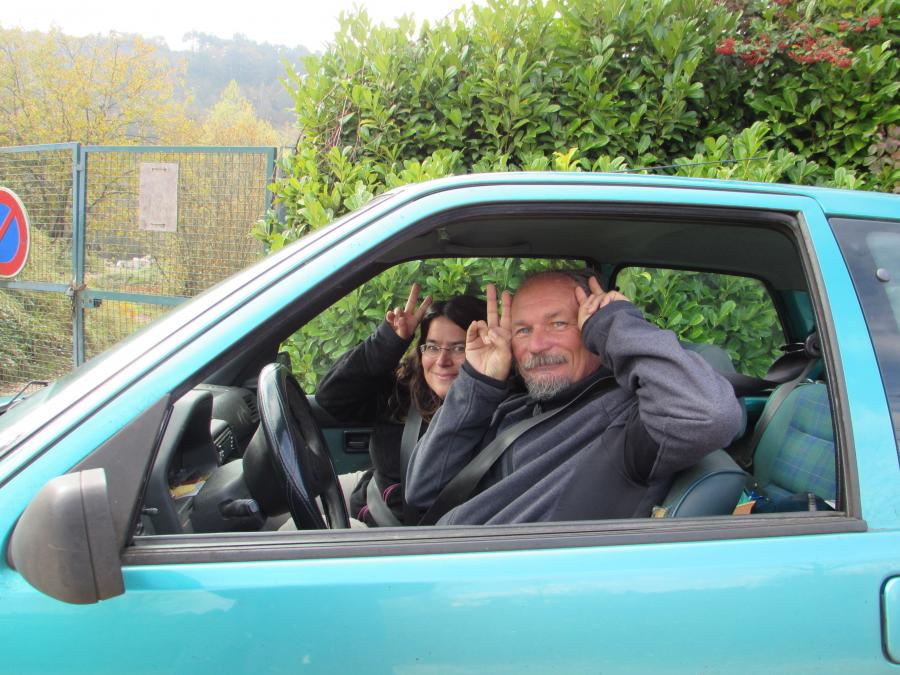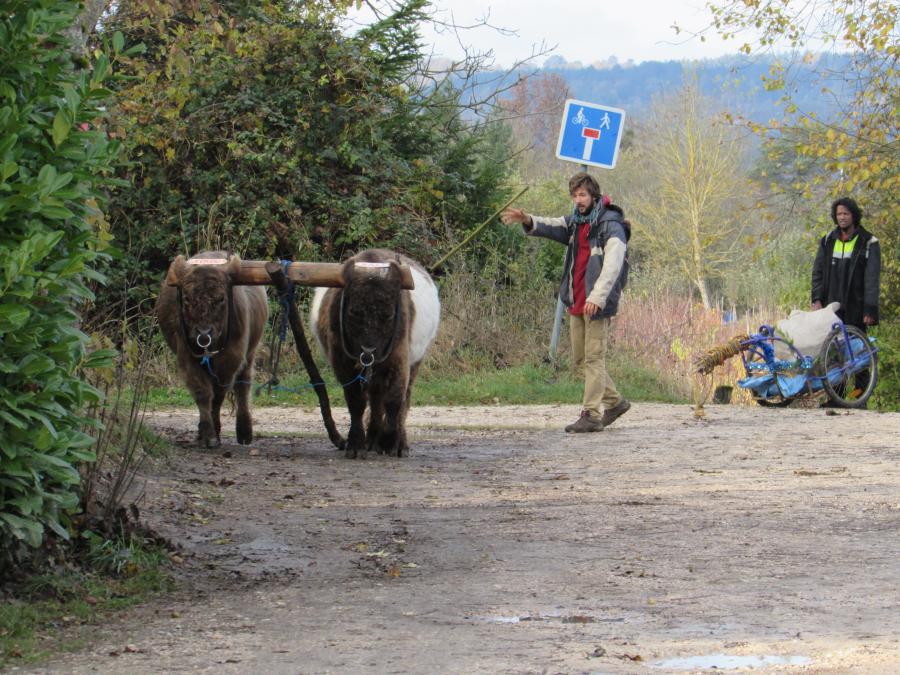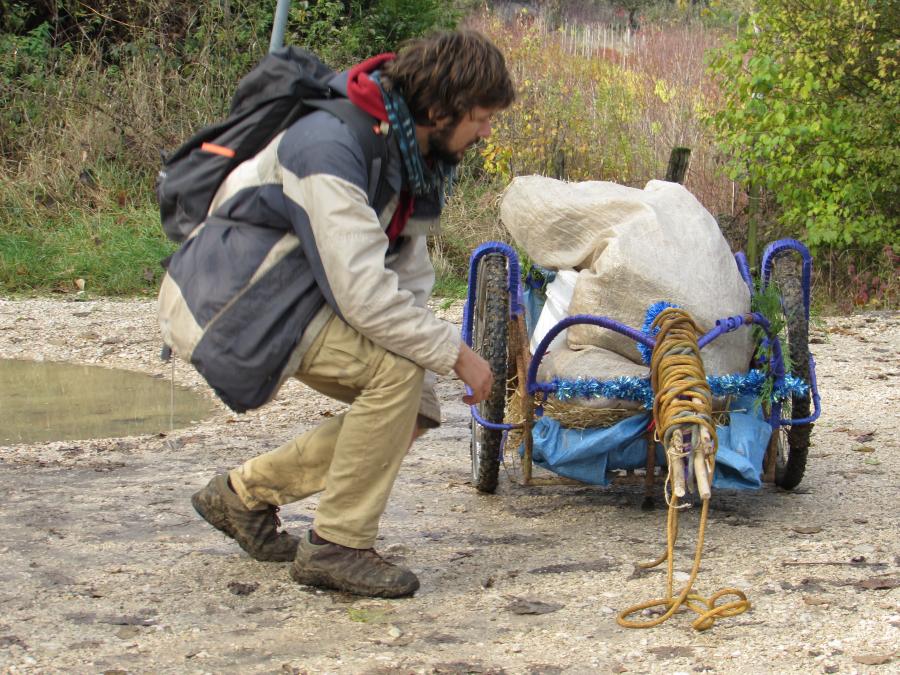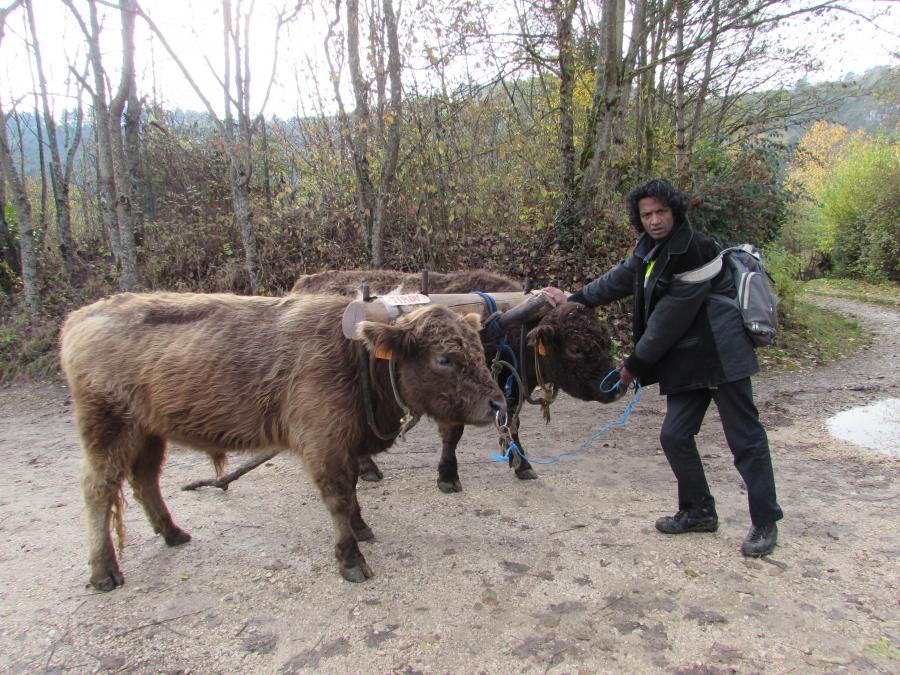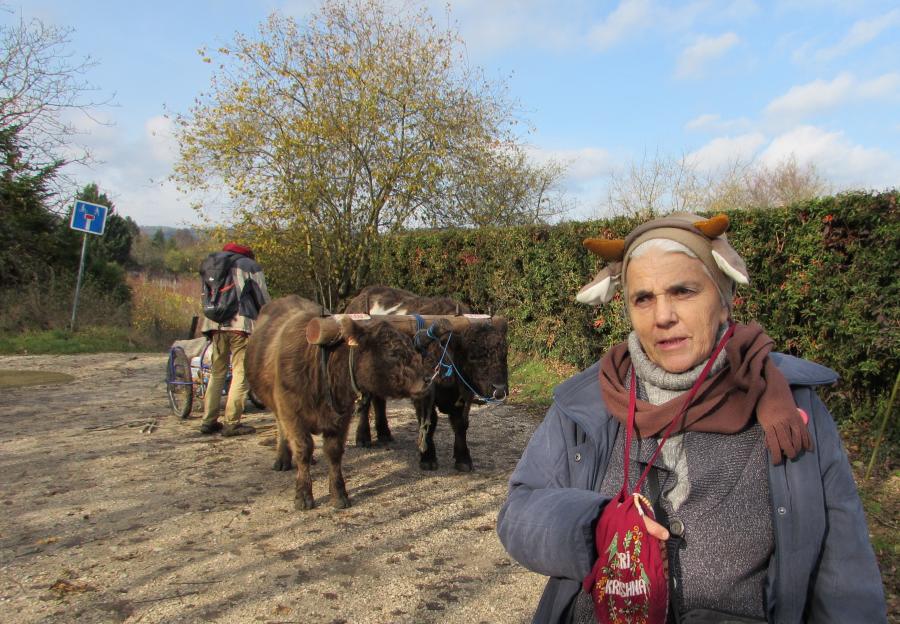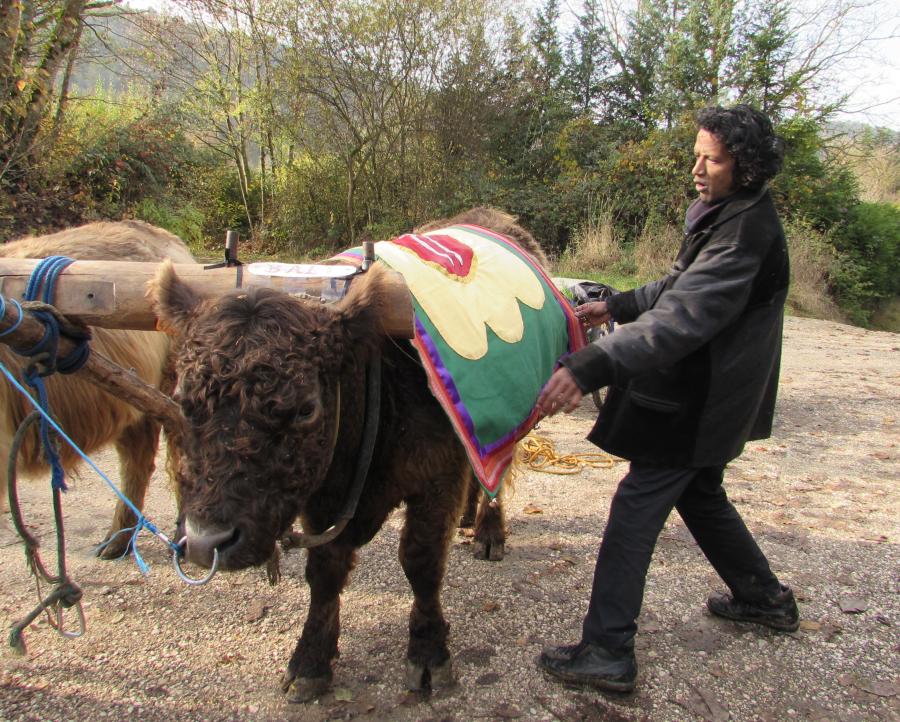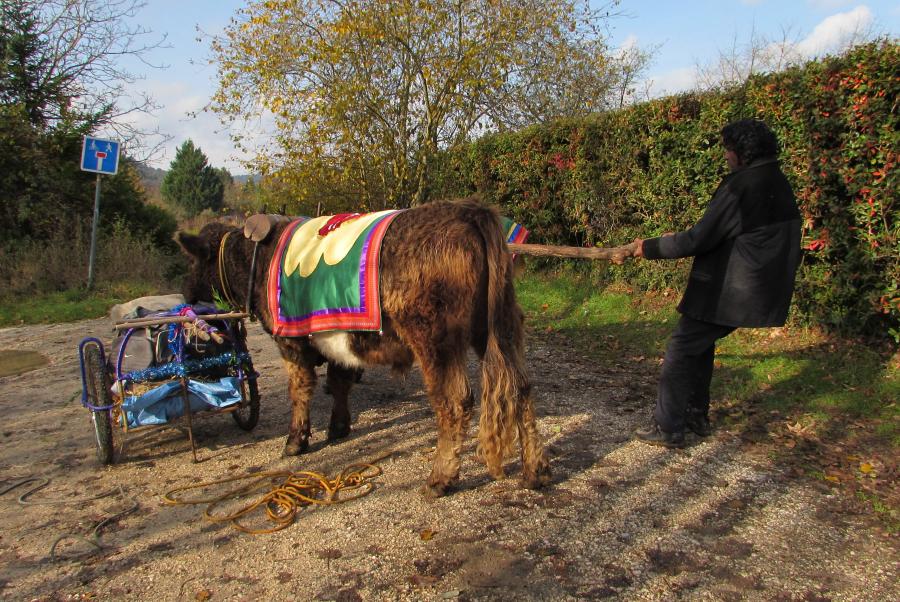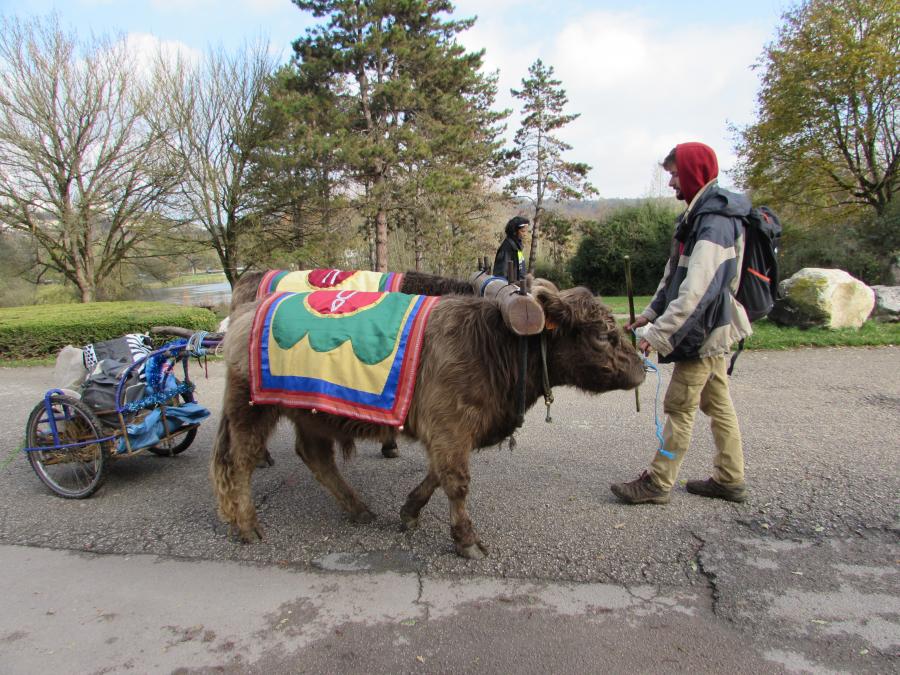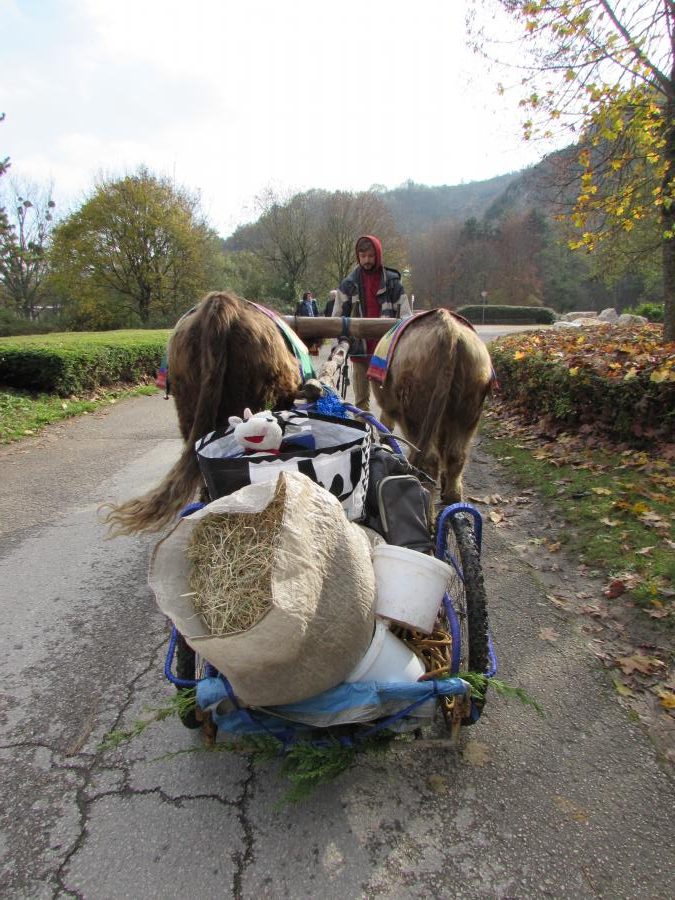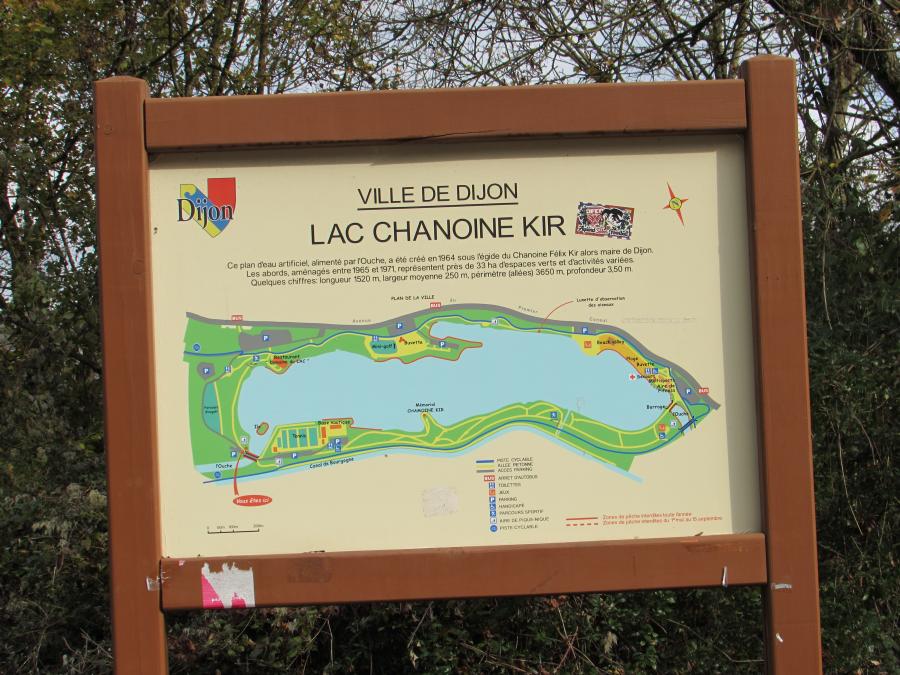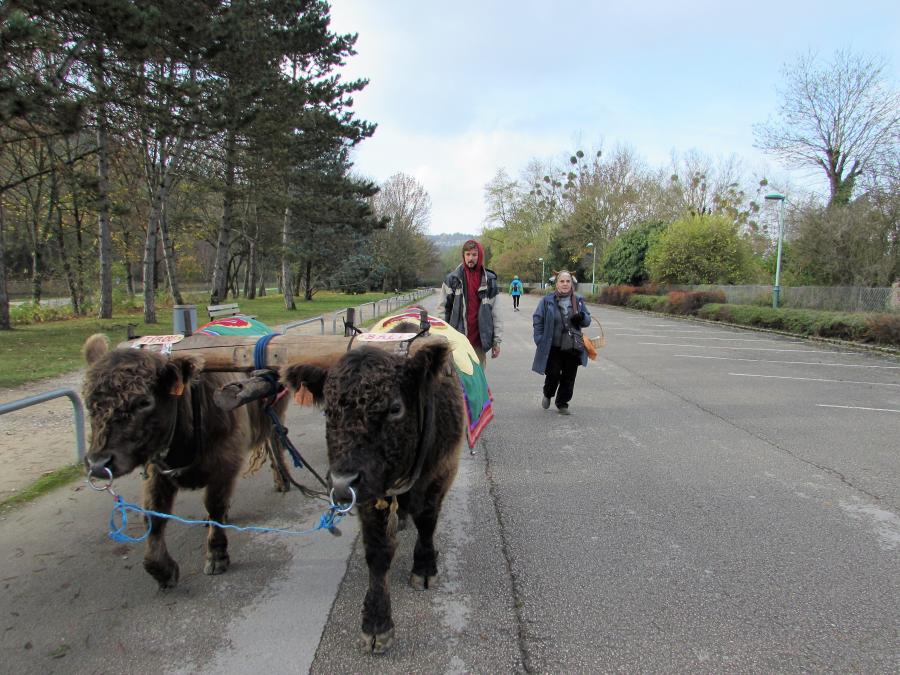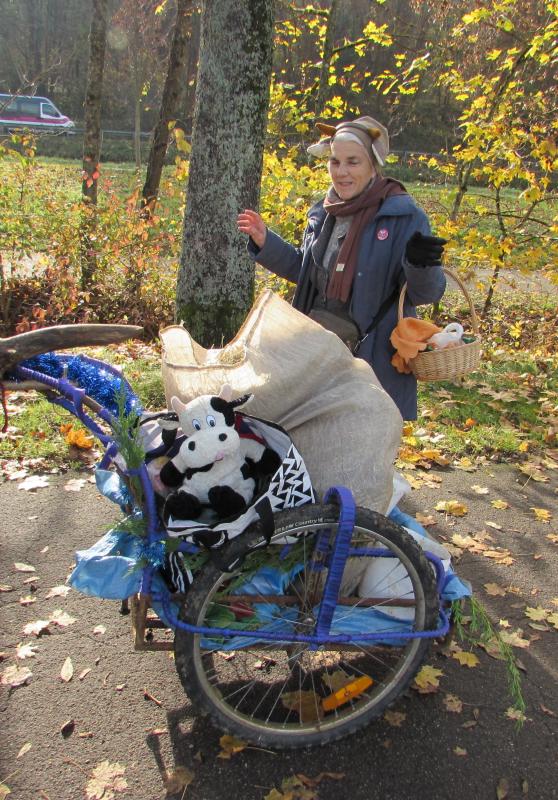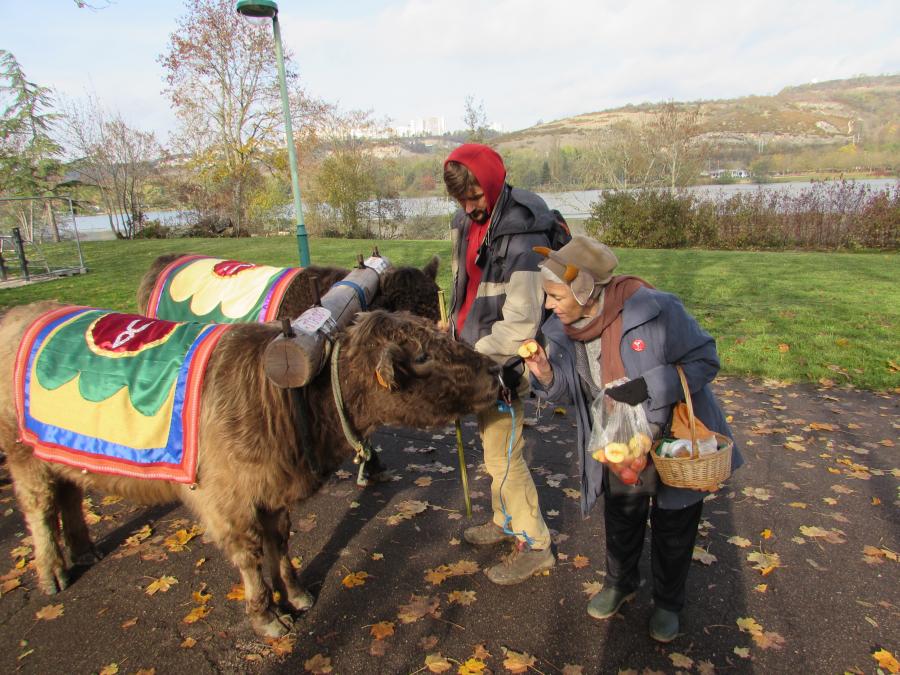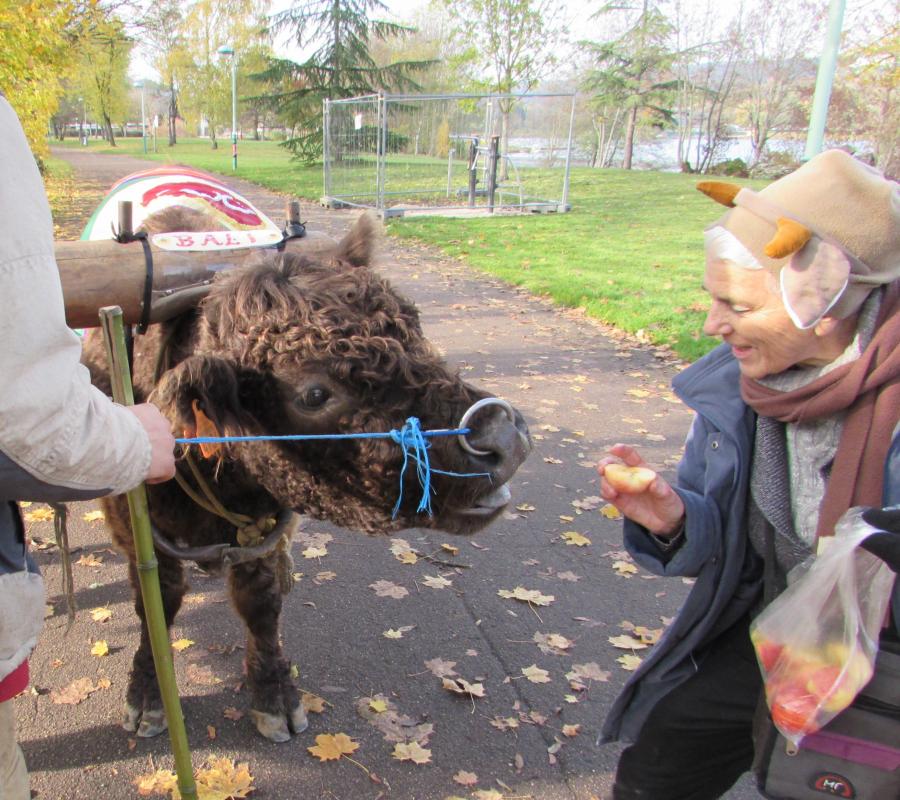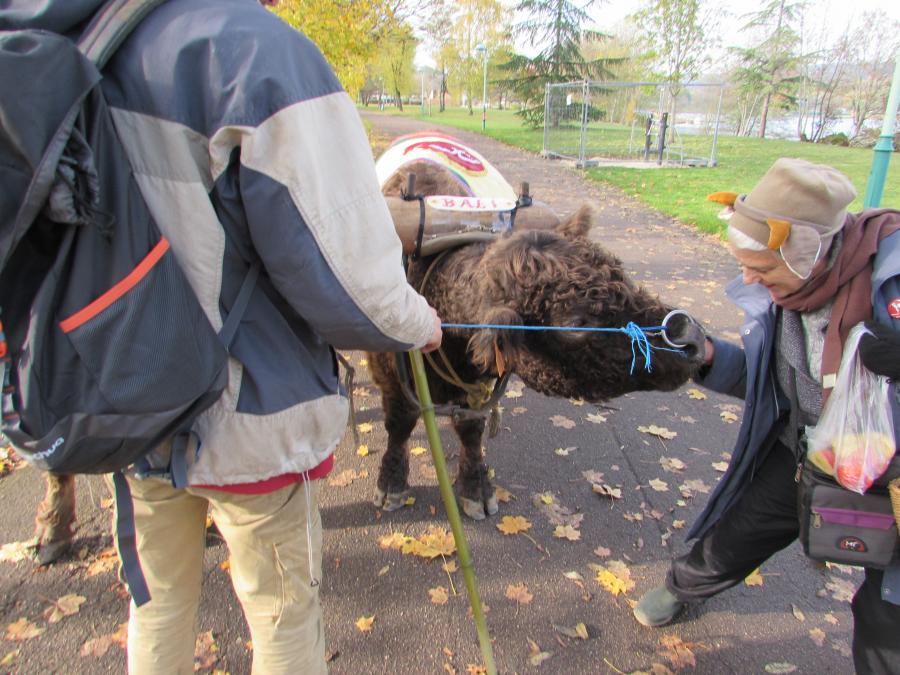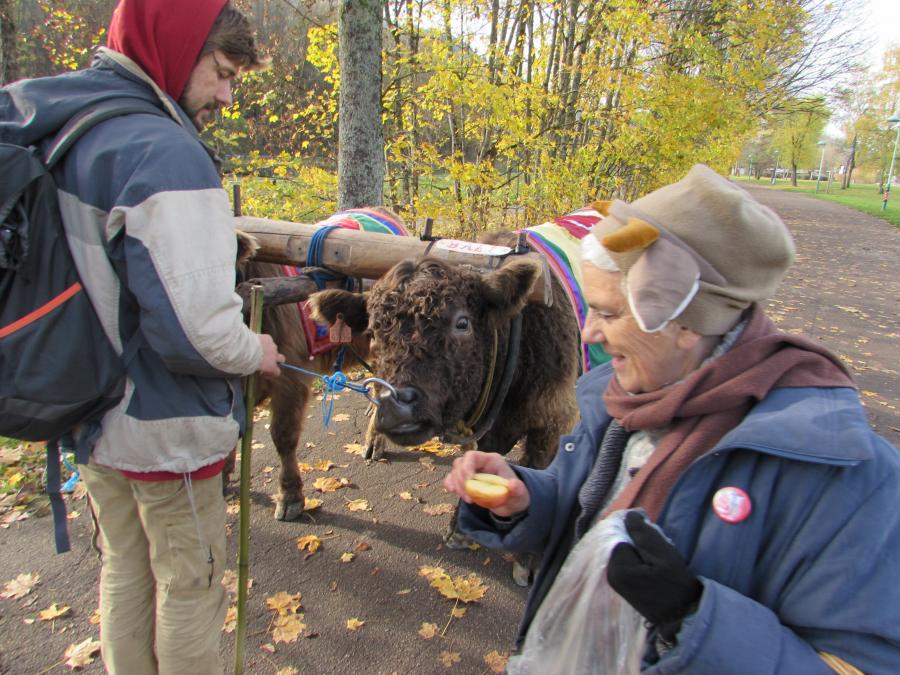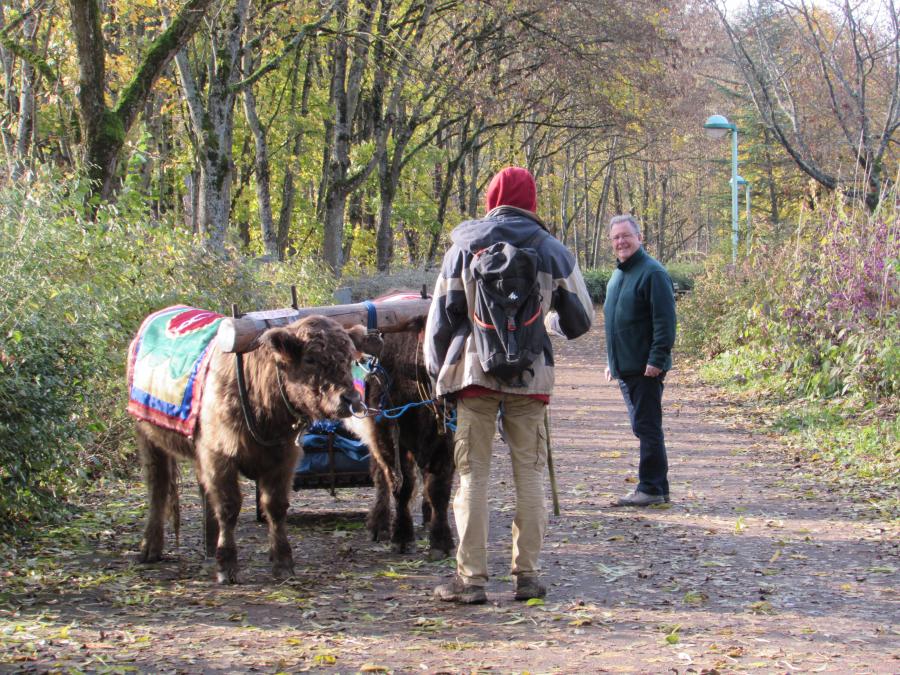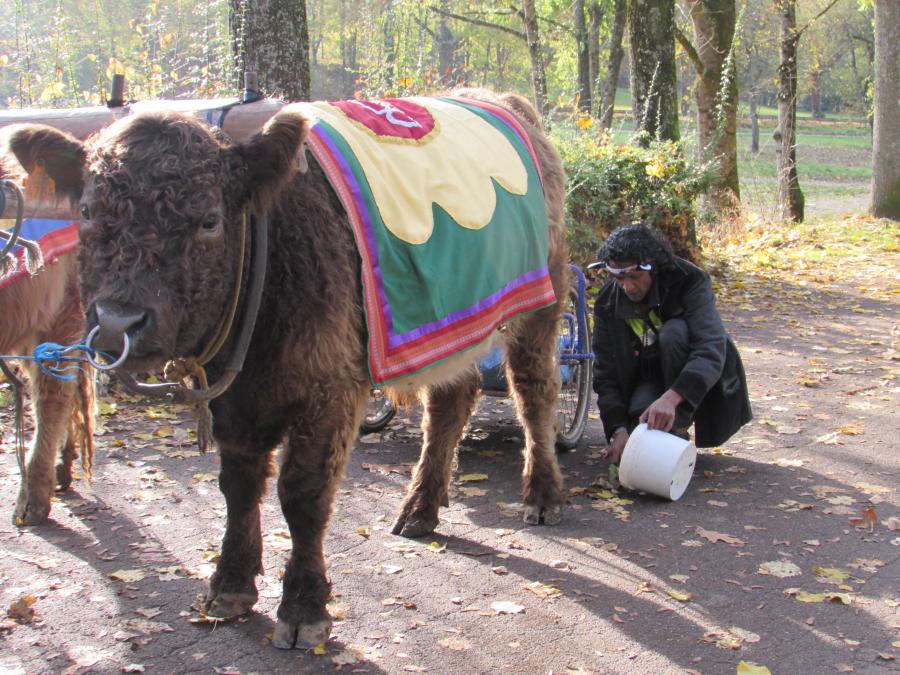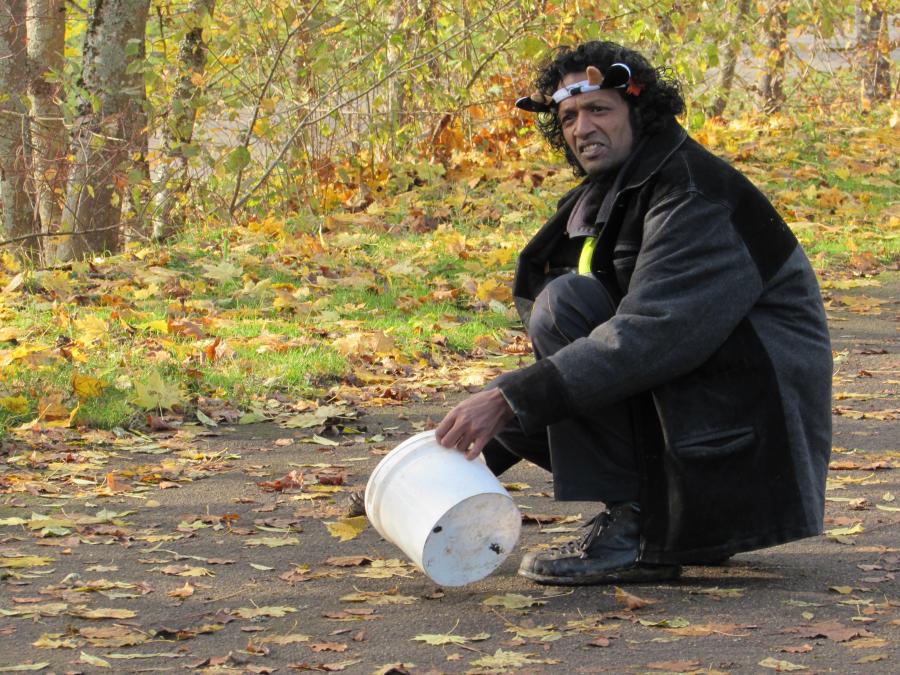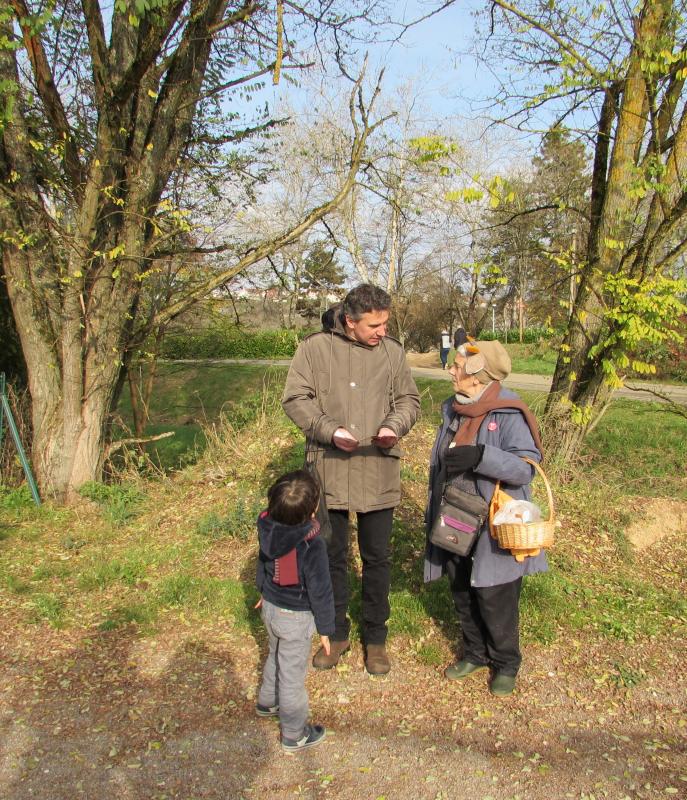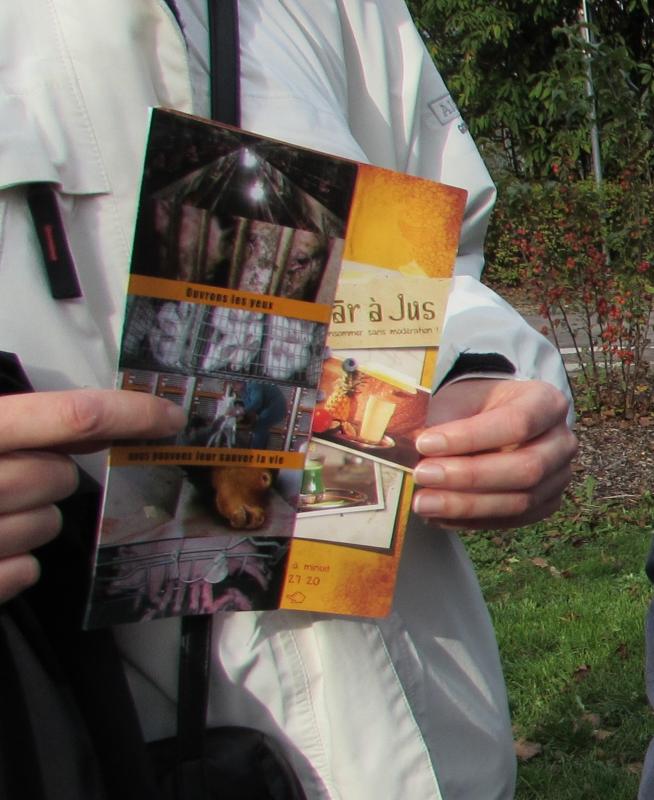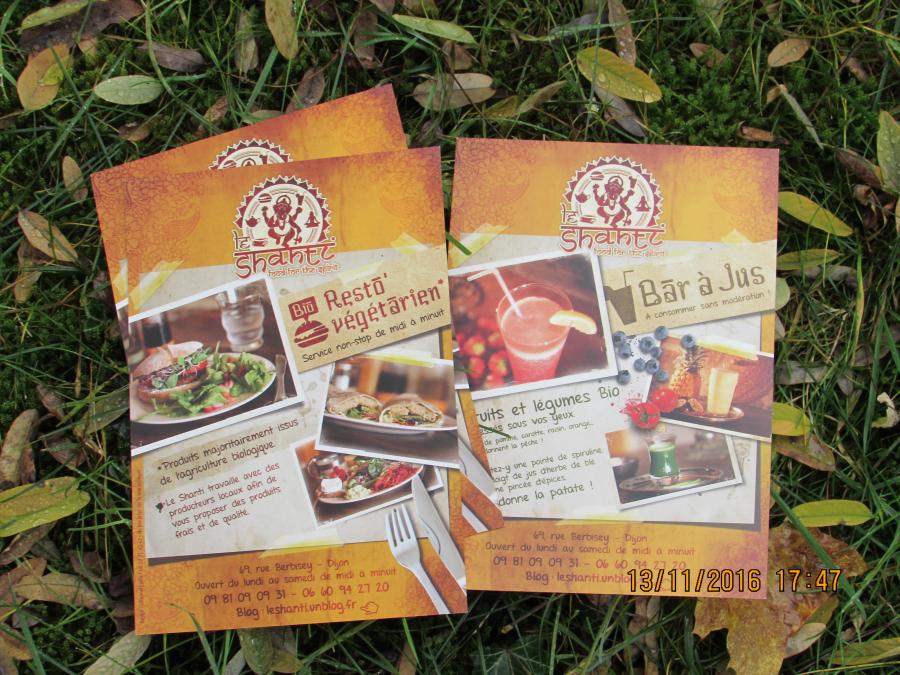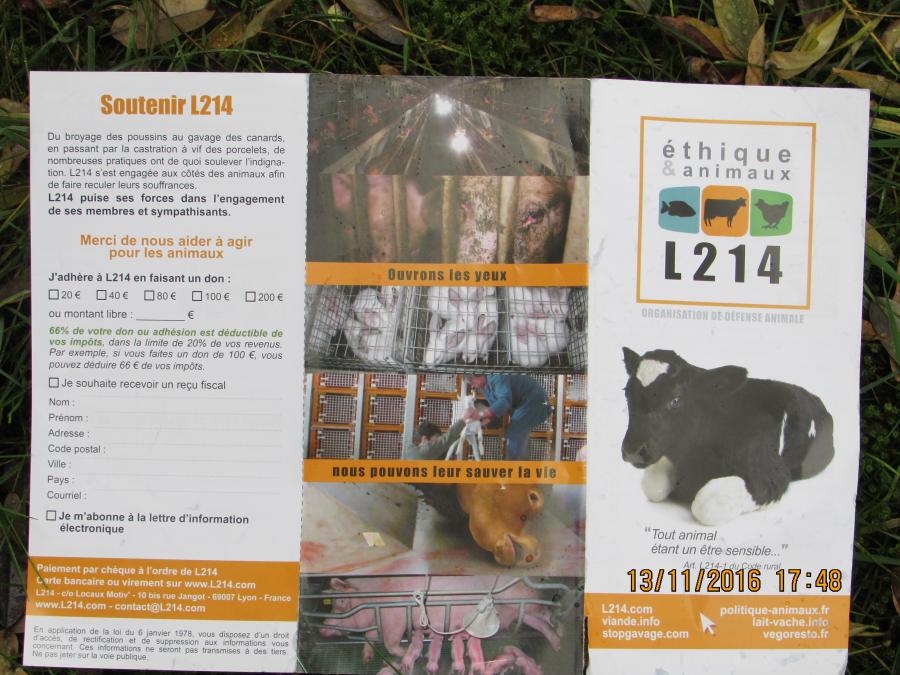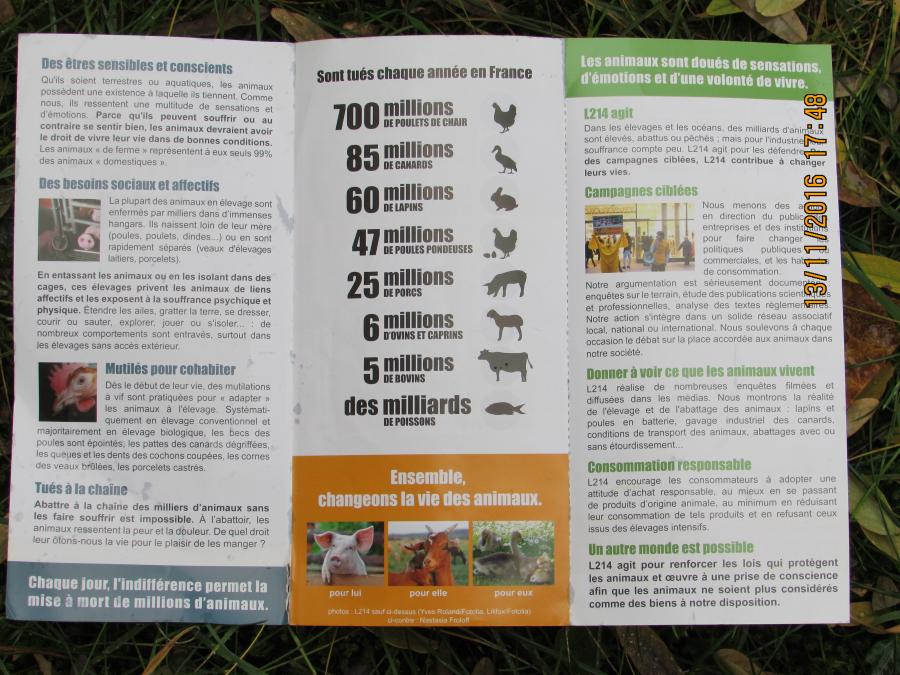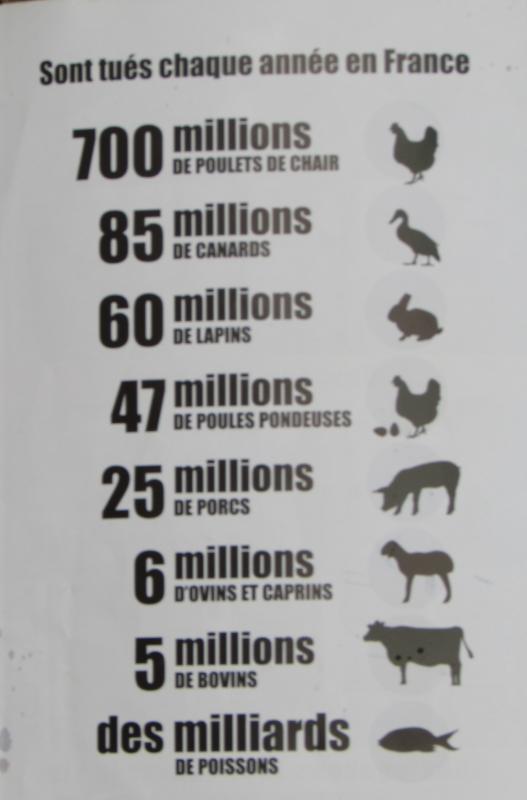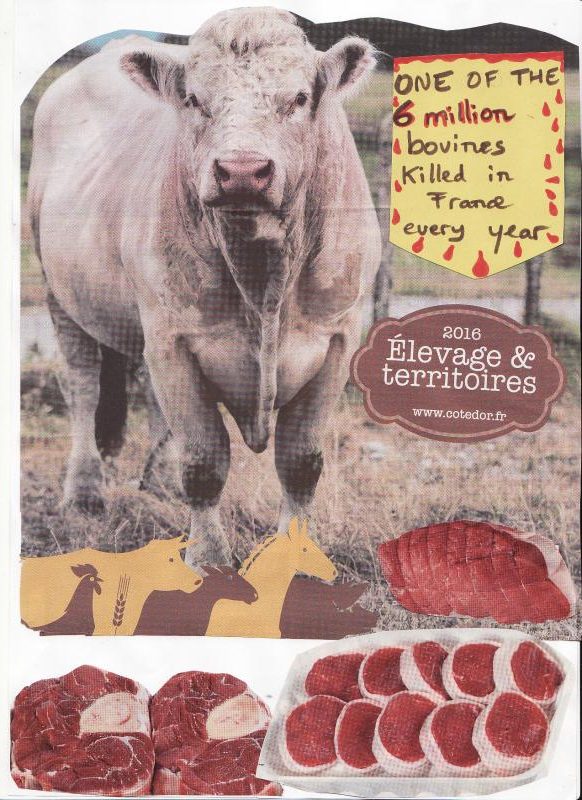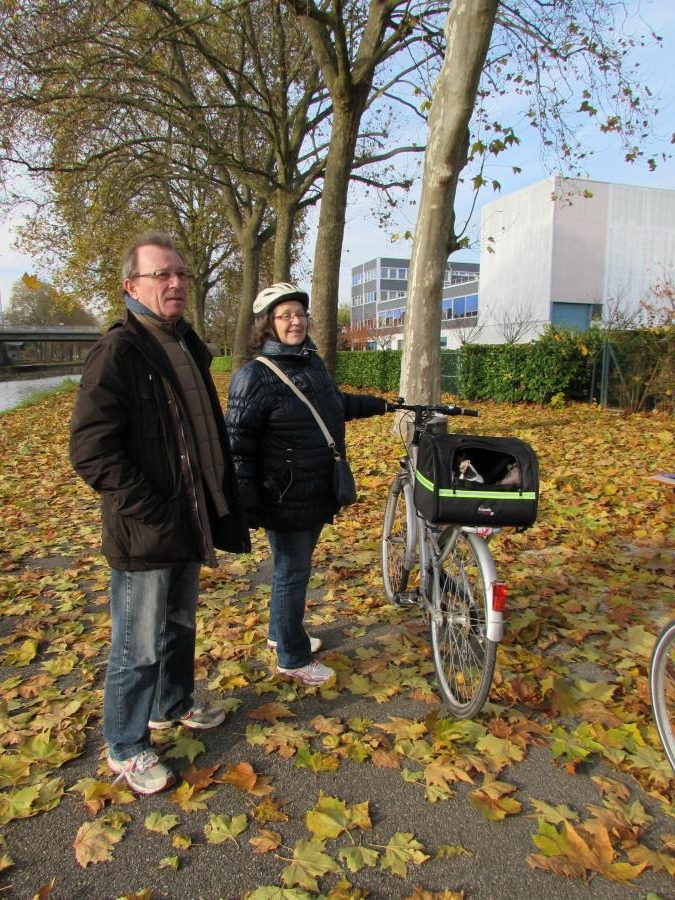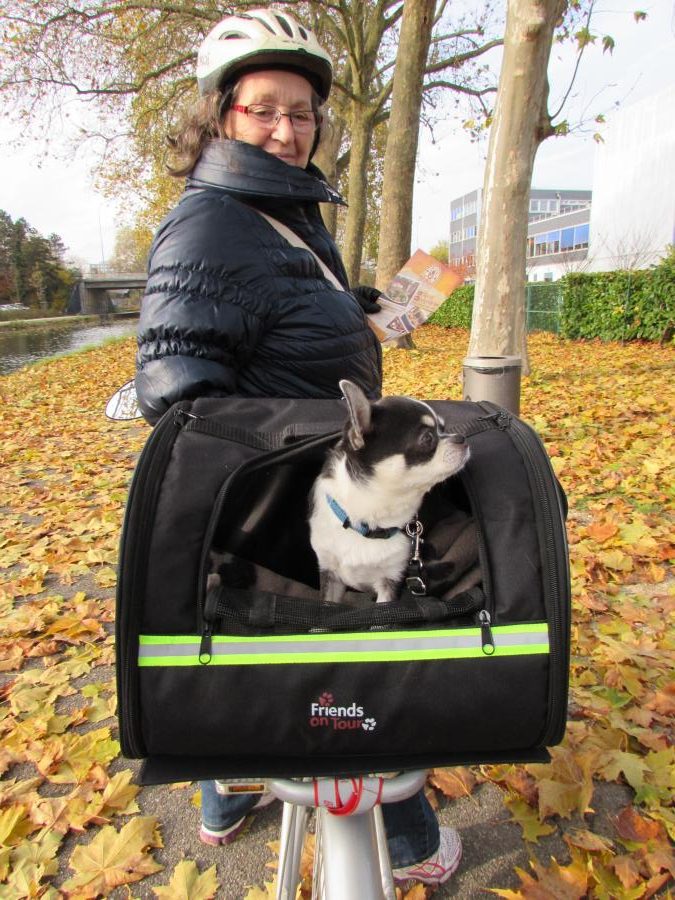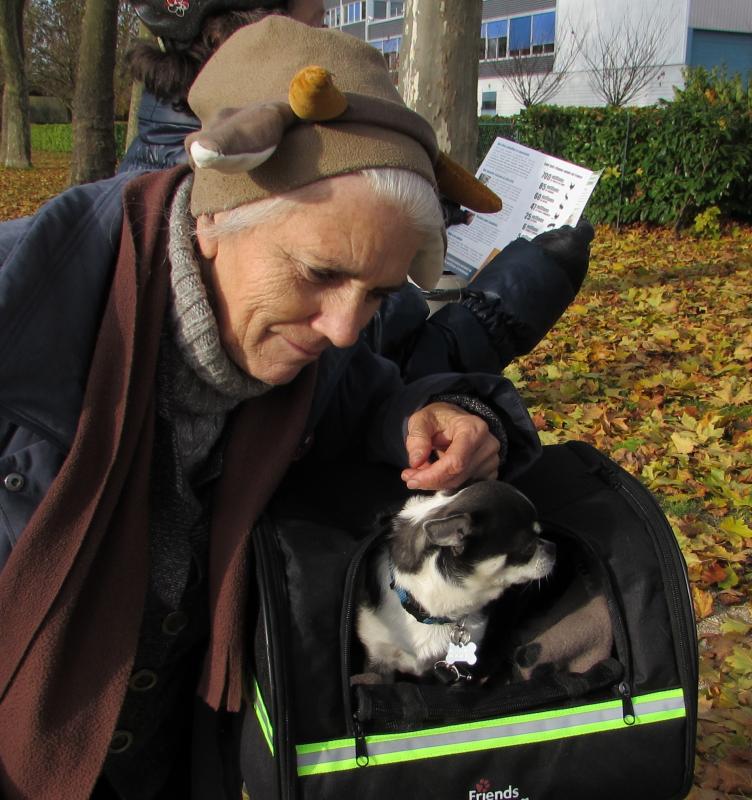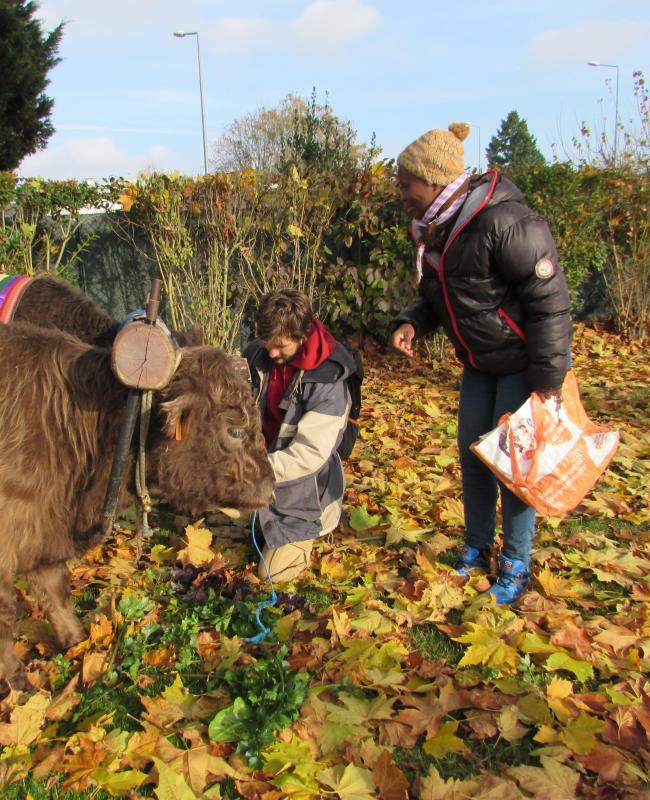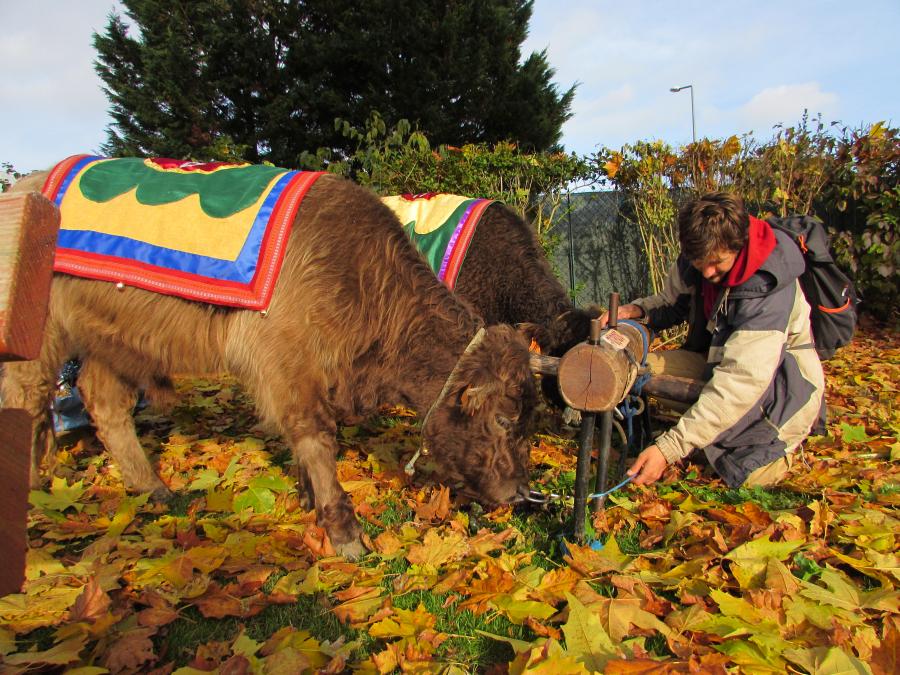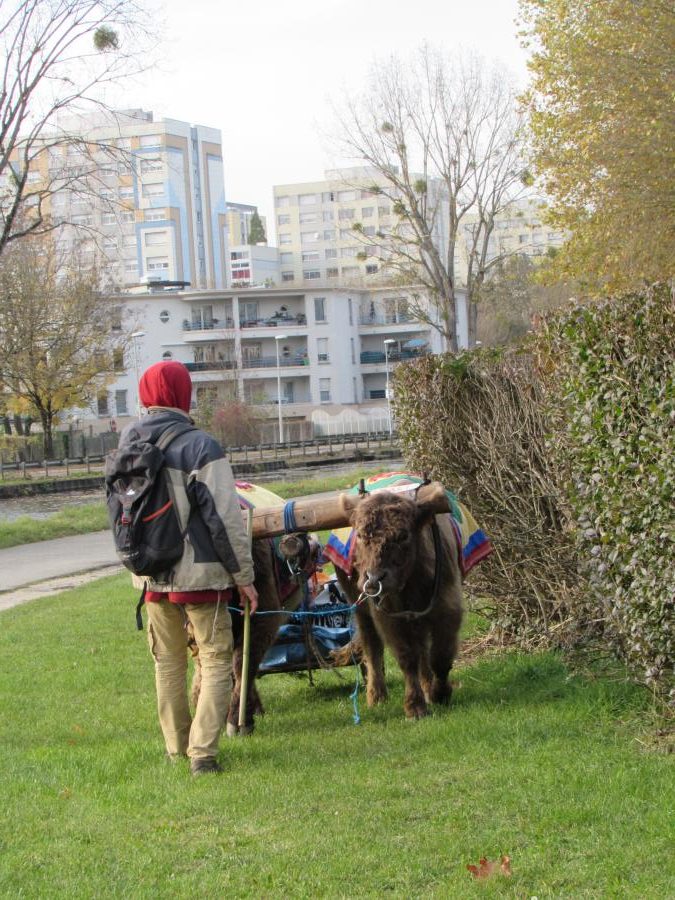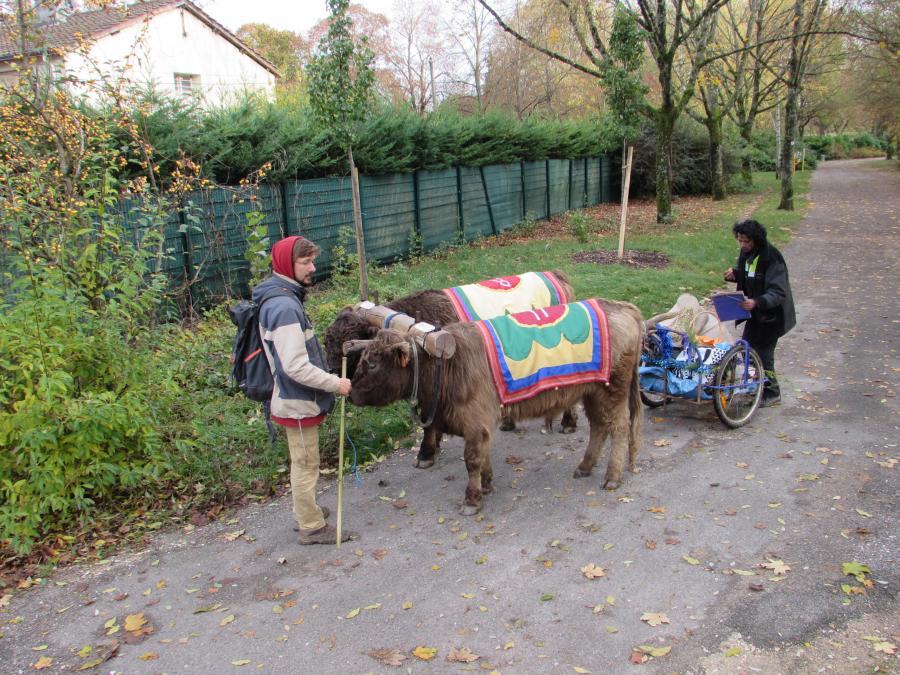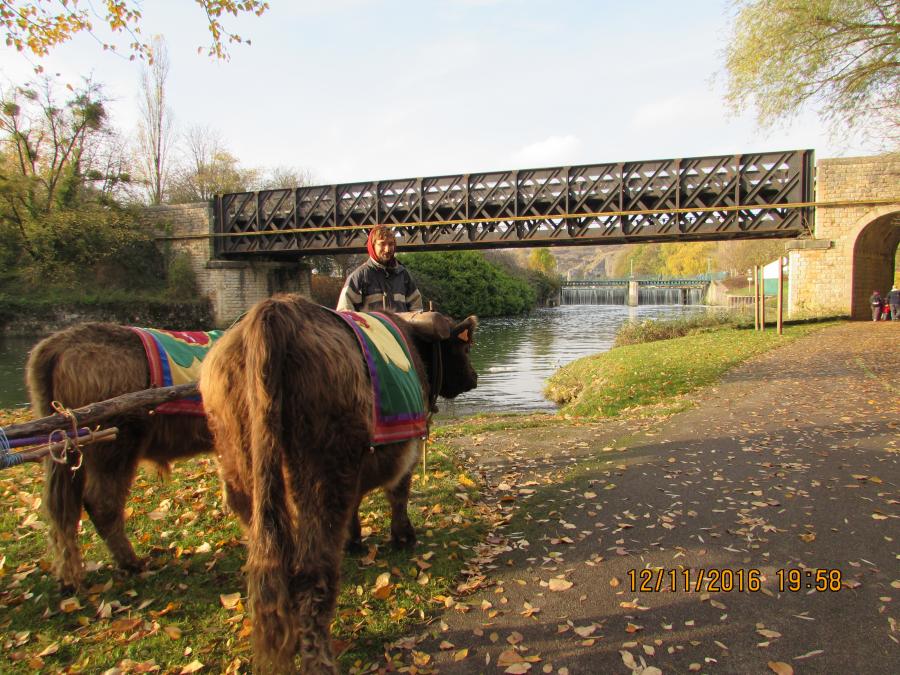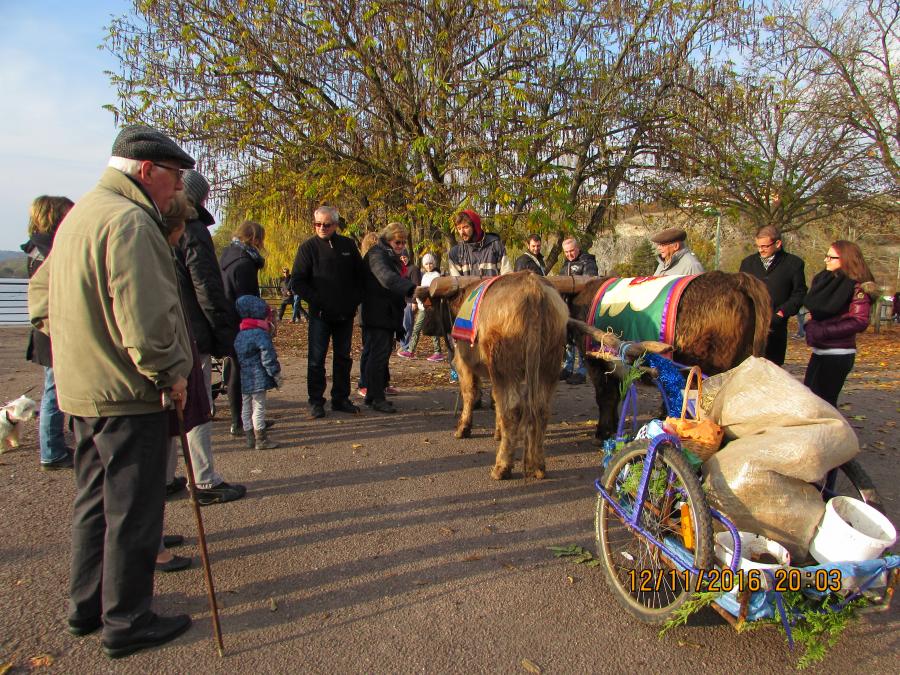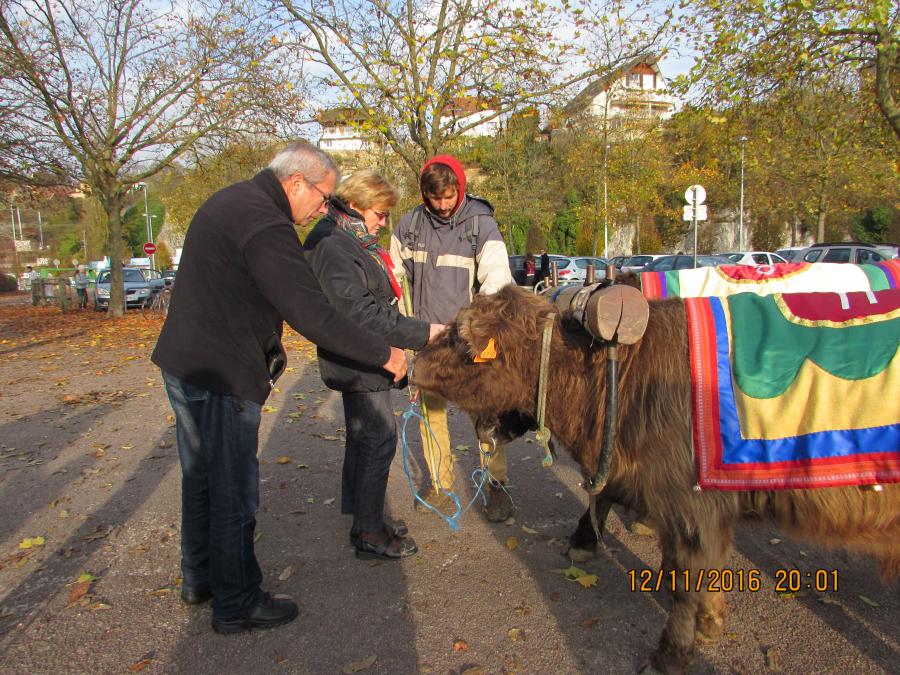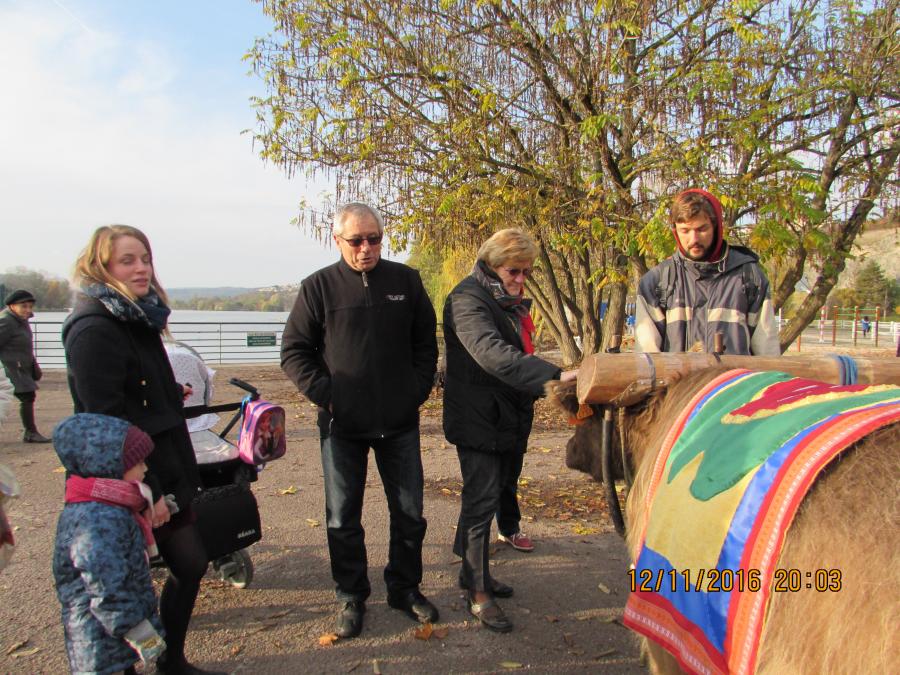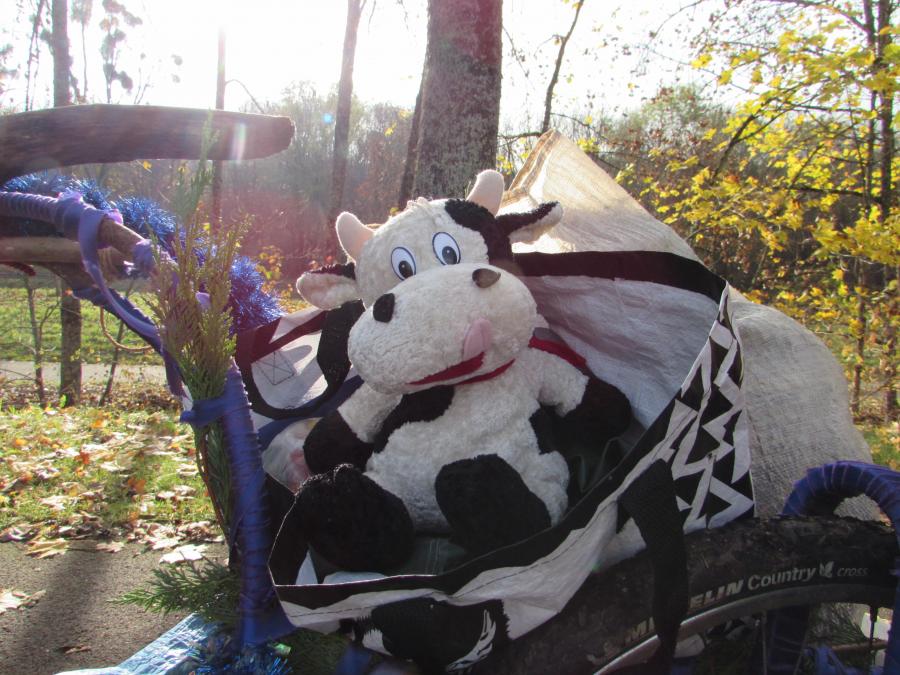By Gaurangi Dasi
A low-key approach in the International City of Gastronomy
Due to the particular situation of the few Hare Krishna devotees in Dijon, a beautiful city of 152 000 people in the East of France, we decided to have a short low-key padayatra on Saturday November 12th . One reason was to reach our goal of 50 padayatras by the end of 2016. Another one was the desire of Rama Gopal Dasa, a 28 old devotee owner of two young oxen, to take his beloved kids on their first big outing as part of their training. He secured the legal permit to walk with them in a section of the city around Lake Kir – not the delicious kind of kheer made of milk- but a visually tasty location nonetheless. Since that weekend also coincided with the annual Dijon fair, we wanted to attract the attention of the public to what many of them would eat there: the well-known beef Burgundy, a traditional French recipe consisting of the dead bodies of unfortunate cows and steers cooked in burgundy red wine. The fair was advertised on posters having a photo of these sturdy white bovines. With our padayatra locals and visitors would meet Bali and Tirou, the endearing live specimens of the very animals who usually end up in their plates and stomachs, and the only ones in the area that would be loved and protected till the end of their lives. In 2018 Dijon, included in the Unesco world heritage list since 2010, will become the International City of Gastronomy. Its aim is to promote the “ French Gourmet Meal”, with an emphasis on wines. No need to say that the number of cows, calves, bulls, goats, sheep, chicken, frogs and snails (another specialty of Burgundy ) that will be sacrificed on the altar of this huge 20,000 m² complex will be phenomenal. Looks like devotees and animal lovers intending to raise the consciousness of humans regarding the treatment of animals have a huge task at hand!
There is no ISKCON temple in Dijon, but a small group of devotees of Krishna. One of them has a vegetarian restaurant in the center of town, Le Shanti, where he plays Srila Prabhupada bhajanas all day long, holds kirtanas/bhajanas every Monday evening in the cozy cellar and regularly invites various Gaudiya sannyasis and sadhus to talk philosophy and Krishna katha. We invited some local devotees to participate in our padayatra, but all of them had to work that day, so we ended up being three with Ravi, a young man from Indian origins studying in Dijon. As we saw this afternoon it was just the right number for our low key approach. I had also invited members of Combactive, a very dynamic group involved in defending animal rights, and opposing cruelty and slaughterhouses, but it turned out they had their own program that day in the center of town. We’re planning to work together in the near future and feature a seriously organized public event, possibly a padayatra, once Bali and Tirou are fully trained to walk in heavy traffic and comfortable to be surrounded by crowds of people.
Since we did not get the permit as a group of Hare Krishna devotees, we did not distribute any of Srila Prabhupada books or magazines or brochures indicating we are Vaisnavas. We dressed normally and did not wear tilaka. I gave invitations to Le Shanti and brochures from an animal rights group exposing the horrors of industrial raising of animals and slaughterhouses, which gave me the opportunity to easily introduce the notion of karma and divine justice to the more receptive people. I knew they could learn more about Krishna and the philosophy in Le Shanti, after enjoying a vegetarian meal and reading some pages of the many books available for perusal.
Tirou and Bali, two adorable Galloway kids
Rama Gopal received his oxcare training in New Mayapur from Jaladuta Dasa, who has been the care taker of his own oxen and the New Mayapur cows for a total of more than 20 years. After moving out from there, Rama Gopal decided to get his own oxen with the idea of putting them to work in the fields, and eventually to haul heavy things, transport goods, and walk on padayatra. He also had in mind to propose oxcart rides to the public, as Jaladuta had successfully done in the south of France. He chose young bulls from the Galloway breed, not very common in France, but because they do not have horns, which might be safer for people around them. He travelled to the nearby Jura mountains to buy his two kids, one year old Bali and six month old Tirou. He soon had them castrated by a veterinarian so they would switch from the passionate mood of bulls to the peaceful behavior of oxen.
According to Wikipedia the Galloway is one of the world’s longest established breeds of beef cattle , named after the Galloway region of Scotland, where it originated, during the 17th century. It was then introduced in many parts of the world, such as Canada, the United States and Australia. After a foot and mouth crisis during the 1970s the breed is enjoying a revival, due to the demands of the beef market, as Galloway have high-quality meat. Due to the climate of their native Scotland they have a thick double-layered coat that is wavy or curly. The coarse outer coat sheds wind and rain, while the soft, fur-like under coat provides insulation and waterproofing. This thick coat of hair insulates their bodies so well that they have a minimal outer layer of fat on their bodies; the coat sheds out in the summer months and in warmer climates. The average Galloway cow weighs 1000 to 1500 pounds and the average bull weighing 1700 to 2300 pounds.The Galloway is naturally hornless, and instead of horns has a bone knob at the top of its skull called the poll. They are naturally very docile animals and can live up to 25 years.
Bali, being older than Tirou, behaves as his older brother; having the same father, they are indeed brothers. They are now three years and two and a half years old respectively, and still behave like children who want to be free to play around. One day Bali, desiring to explore the world around him, ate some hot cinders from a campfire; happily he did not hurt himself, but probably learned a good lesson from that experience. Rama Gopal and his babies moved from one place to another several times over the years, and, due to his parents’generosity, he just bought a small goshala for them consisting of a shed and a small yard. The goshala is located at the edge of Dijon, just a few minutes away from Lake Kir and the surrounding park, in the area of nurseries, which turned out to be a great advantage, as one owner of several nurseries lets Ram Gopal take his oxen to graze the rich grass and weeds between fruit trees. He started to teach them commands just a couple of months ago, after he received a wooden yoke from Jaladuta. Four days a week he puts the yoke around their necks, secures a long wooden pole to the pole to create some weight, and takes them to a meadow around the lake to teach them to respond to the four basic commands: “Dji” means “Right!”, “Ho” means “Left”, “Woo” means “Stop” and Hop” means “Go”. Sunday is their rest day: no training, no work, they can eat as much grass as they want in the meadow and the nurseries. Tirou and Bali are becoming a familiar sight to the many joggers and walkers, and they recently got featured in the internet version of a local newspaper.
By spending time around oxen we can see that they are individuals, with their personality and preferences. Bali has a flickering disposition whereas Tirou possesses a more steady mood. Their personality also changes as they grow. Bali is now in his adolescent period, and he expresses his grumpy moods by mooing a lot. One time he refused to walk and just lay on the ground in protest. When younger, Bali was crazy for banana peels, but he now prefers sweet apples. Tirou is very picky about his food; Rama Gopal has to present several times the same item before he decides to eat it.
Ready at last to circle the KirLake!
As every Saturday, Ravi arrived early at the goshala to take care of Bali and Tirou –by brushing them and cleaning their shed and yard. While I decorated the cart Rama Gopal took advantage of the mild weather to trim some bushy trees surrounding the yard. Ravi’s tender caring gestures were rewarded by a very loving kiss from Bali, which made him really fit his name, as “ravi” means ‘delighted’ in French. I was a little jealous not to get the same treatment, but I had to admit that I did not yet have a relationship with any of these oxen, besides giving them some occasional pats. So when Bali started to swoop on me in a displeased mood, I thought it safer to retrieve behind a door as I did not want to have a close encounter with his 400 kgs curly body, even though this race of oxen does not have horns. Finally, Ram Gopal forgot about his trimming and fixed the cart to a long pole that he connected to the harness fixed around the oxen necks. Everything seemed ready. Only one hour behind schedule! So we headed on the dirt path leading to the bigger road around the lake. But after only twenty meters the cart separated from the pole. No need to be an engineer to figure out what to do: I told Rama Gopal to fix a piece of wood perpendicularly to the pole and attach the rope around their intersection, and it worked. Patience not being one of my virtues, instead of fuming, I decided to do something positive -chant some rounds and help dress up Tirou and Bali.
The oxen looked so cute and elegant in the colorful outfits I had sewn entirely by hand, with a little help from my friends towards the end. The bright colors and designs attracted the attention of people walking a little distance away in the park surrounding the lake. To feel more part of the bovine family so dear to Krishna’s heart, I sported my cow headset, with horns and ears the same color as the oxen. We felt very grateful to Lord Indra to be on our side that day: that Saturday was sunny, just a bit chilly, whereas the previous days had been rainy and colder. There was a good number of people walking their dog, running, jogging and bicycling around the lake.
Meeting many friendly and curious people along the way
Since this padayatra was a long training day, both the oxen and Rama Gopal were tested. For the first half of the walk we heard more ‘Bali dji! Bali ho! Bali woo! and Bali hop!’ than “Hari Hari Haribol”. Good thing Bali is the name of a great devotee who surrendered everything to Lord Krishna. This helped me reflect on the poor state of my own surrender. Young oxen behave a lot like young kids who want to explore their surroundings, have a little fun and enjoy some sweet treats, so Bali was often veering to the side to eat some tasty grass, to walk on the smoother nearby meadow or maybe just to see how his master would react to his mischievous behaviour.
I copied an idea I had seen in Paris at a festival for alternative energies and against food waste : ask people to pose for a photo of themselves with the oxen while holding a panel of their choice. During the Alternatiba festival the panels said “ I will use a bicycle”, “ I will not waste vegetables”, and on this padayatra they said “I do not eat my friends”, “I will stop eating meat”, and “Oxen, cows and calves want to enjoy life also’. But I was so busy talking to the people, distributing brochures and taking photos that I did not have many opportunities to use these panels, even though I suggested it a few times. Will try this out in the future, for sure. Might have been too much of a big step for most people. Neither did I see many of them willing to take a few slices of prasadam mandarins I had put in a basket. Maybe people were a little reluctant to eat food offered to them by people they did not know.
Talking about vegetarianism and cow protection
However, people were eager to pet the oxen and ask questions, such as “What are these?” Our answers: Galloway oxen, Not large goats as some people had suggested before, Neutered bulls, so they can walk and work peacefully, The animals you eat as steaks. “What are they doing here?” : Taking their first big walk, Getting used to roads and people, Reminding you of what you eat. “Where are they from?” They are residents of Dijon, but the owner bought them in nearby Jura. Whenever one of the oxen would loudly bellow, I would translate his verbal message to the listeners, ‘Love me, don’t kill me, don’t eat me! “ Bali and Tirou melted many hearts that day, and at least made some people think of what they eat, or rather of who they’re eating. On my side, it looked like I found a way to Bali’s heart, at least for a while, though his belly, by giving him cut apples. Whereas Tirou showed no interest at all in the fruits, Bali’s eyes lit up and his tongue greedily extended towards my hand to catch the juicy treat as he kept asking for more. I had done the right thing by cutting the apples in two, as I knew that you never give an ox an entire apple, which can get stuck in his throat. Some oxen are indeed very fond of sweet fruits, and I’ve heard stories of one padayatra ox getting drunk on them, and another one throwing a devotee up in the air from behind to grab the oranges in front of her.
One middle age couple transporting their tiny Chihuahua dog in a basket attached to their bicycle were as much curious about the two oxen as was their dog, who kept staring at Tirou and Bali, apparently appreciative of the power and size of these two creatures in front of him. We talked for a while about animals being persons, souls in different kinds of bodies, and the disastrous karmic consequences of mass scale slaughter. The couple agreed with me, that terrorism against animals breeds terrorism against humans, and looked interested to check out Le Shanti vegetarian restaurant. Hard to say what dogs really think, but I noticed that none of them, especially the small ones, dared to venture too close to the oxen; they all kept a safe distance and abstained from any barking comments. They were probably as impressed as the humans were by these two beautiful oxen. One lady run to her nearby garden and came back with fresh organic vegetables and roots for the delighted oxen. When we walked on the most crowded side of the lake, small groups of people gathered around the oxen and listened attentively to what we had to say. As it was getting cooler and the sun was ready to set, we walked back to the goshala, crossing the park surrounding the lake.
The success of this mini padayatra was an indication of the impact it would have once Bali and Tirou were more trained and with a larger group of participants, devotees and animal lovers. We hoped that some of the people we met that day seriously reflected on the plight of the millions of animals tortured and slaughtered and started to change their eating habits. Many people say they are reducing their meat consumption, eat more fish and less red meat, but I point out to them that fish also suffer and that the few animals they eat add up to huge numbers on a national level. The annual statistics for France alone are frightening: 5 millions of bovines, 6 millions of sheep and goats, 25 millions of pigs, 47 millions of eggs producing hens, 60 millions of rabbits, 85 millions of ducks, 700 millions of chicken and billions of fishes.
What a linguistic analysis reveals of French people attitudes towards cows and oxen
In the past I studied latin and linguistics and still have a keen interest in the root of words, their various meanings, how they’re used and what they reveal. About twenty years ago I gave a conference during a Women Ministry meeting in Radhadesh in which I presented a linguistic analysis of the vocabulary used in ISKCON to designate Vaisnavis. Not an encouraging or enlightening list, alas. One of them was “stupid cow”. In fact, I’m the one who was the recipient of that reprimand the day I did a wrong maneuver while backing the sankirtana van on Padayatra UK. Since I love cows, who are very intelligent, wonderful animals very dear to Krishna, I took this as a compliment, but still, it kept me wondering about the mentality and realisations of that male devotee who tried to insult me that day while also offending mother cow.
In France, a very common use of the word “cow” is a very pejorative one, as it indicates someone tough, hard, pitiless, or something unexpected and troublesome . The derivative word “vacherie” also indicates a mean act or word. It’s sad that cows have been associated with something bad and negative in the collective French unconscious, especially because the expression “Mort aux vaches!” (Litt. death for the cows) addressed to the military, police and any kind of authority, was not originally meant to insult cows. The expression’s first originated at the end of the 16th century when Henry IV besieged Paris. Since his flags bore two cows, the Parisians created this insult. The second origin goes back to 1870, at the time of the war between France and Germany. The word “Wache” (sentinel in German) was written on all the German military posts, and the French then shouted “Mort aux Waches! ]”(Death to the [German] sentinels) which became transformed to “Mort aux vaches!” (Death to the cows!). By extension it came to designate members of the police and other authorities. Looks like it’s time to positively affect the collective consciousness of French people by talking more about cows’ value and qualities.
Happily, by looking in the dictionary at the words cow (vache) and ox (boeuf) I discovered that many uses are very appreciative of these animals. It’s not surprising if we know that until a recent past all French farmers used oxen to till their land. My father was one of them, as well as many of the old people we met on our three-month Padayatra France twenty years ago. One of these old farmers was so thrilled to see oxen again that he begged Sundar Gopal, the padayatra organizer, to make a detour to their village on market day. He wanted to show the oxen to all his friends. He was totally oblivious of these strange people with tilak, dhotis and saris, – at that time the Hare Krishnas were considered a dangerous cult in France- he was just mesmerized by the majestic oxen.
Some expressions reveal the place cows and oxen had in people’s life. One of them “le plancher des vaches” (literally the cow’s floor) refers to the earth on which we walk. At the end of the Middle Ages sea travel was at a peak, and it was not rare that some people were at sea for months before they were able to walk on firm ground and see cows again. So these sailors called the earth “the floor for cows” in contrast with the moving floor of their ships. The « montagne à vaches » (Mountain for cows) refers to a mountain one can easily climb. There are still parts of France where in spring herds of cows are taken to small mountains to graze for the summer months. The noun “vache” and the corresponding adverb “vachement” are both used in a complementary way: « une vache de petite maison » means a fantastic house and the adverb “vachement” is a superlative indicating abundance of something. Oxen receive the best share of positive expressions. A person as strong as an ox is obviously very muscular and energetic. “Travailler comme un boeuf” (litt. to work like an ox) refers to hard and relentless work. “ Avoir un success boeuf” (litt. to have an ox-like success) means enormous, prodigious. And the most common expression “mettre la charrue avant les boeufs” (litt. to put the plough before the oxen) indicates to start with a task that should have been done at the end, ie. to do things in the wrong order.
We’ll end this little linguistic analysis with two expressions. The first one is a humorous one,
« Parler français comme une vache espagnole” (litt. to speak French like a Spanish cow), meaning to speak French very badly. Obviously cows, including Spanish ones, do not possess the ability to speak, so how could they speak very poor French? Once again, the expression has several origins, but the most possible one is a combination of pejorative terms used in the XVII century. “Like a cow” had in general a very negative connotation and “Spanish” also referred to something or someone unpleasant. The second one refers to the present horrible life and death of millions of dairy cows in industrial farming. To call someone a “vache à lait” (Litt. a cow meant to give milk) indicates a person who can be unlimitedly exploited in order to get some advantages from her -usually financial- without her protesting, just like the cows, from which humans take milk without much consideration for their well-being. Those who know the inhumane conditions of modern dairies can understand the full import of this expression.
Cow protection and ox power go hand in hand
When we talk about cow protection, we should not forget that it goes hand in hand, or rather hoof in hoof, with putting oxen to work. Otherwise, what will happen to the all the bulls that take birth? When bulls are neutered they are called oxen; they then loose their passionate nature and become very apt, and happy, to use their strength to work in the fields, to pull the handle of an oil-pressing machine, or to haul heavy loads. Padayatra is one of the ways in which to put them to work, and also to directly engage them in the service of Sri Sri Gaur Nitai by pulling Their cart. The experience of oxcart padayatras in western countries for more than thirty years has shown that their presence awakens the interest and affection of the public for these valuable animals, which often results in newspaper articles talking about cow protection.
Lastly, here is a poem I composed to remind us all of the dangers of this age:
THE AGE OF TERROR
By Gaurangi Dasi
Kali Yuga, the age of horror.
Kali Yuga, the reign of terror.
It has all been predicted
Most vividly depicted.
Humanity plunging into depravity,
No more God, peace, sanity,
Hell loose for living entities,
No more caring, no more mercy.
Animals slaughtered by the billions,
Brutally tortured to rake millions,
Entombed in a dark stinky pen,
Treated like objects by cruel men.
All for the pleasure of the tongue,
The list of sins would be too long,
Cows, calves, chicken, calamity!
Sick goose livers, delicacy.
Can’t see the sun, can’t eat the food
That God made for them to feel good.
Stuffed with chemicals to grow fast,
Sick carcasses, we’re left aghast.
For the vanity of elegant looks,
Furrets and hermines are trapped in the hooks.
Chewing their legs off trying to escape.
Beautiful women tempering with fate.
They eat everything that crawls, flies or moves,
Every part they relish, down to the hooves.
Frogs, ants, legs, brains and hearts eagerly devoured,
Discrimination lost, Kali empowered.
In laboratories they make brilliant experiments
To predict the results of car accidents:
Smashing live monkeys just to discover
That hurts do increase, with speed much higher.
They inject shampoo in innocent eyes,
Terrified rabbits perfectly alive,
To test how much their new product is safe
For humans to use, no way to behave.
Let’s all speak up for those who can’t protest
Sensitive beings in lairs, holes and nests,
Brothers and sisters in different species,
For the Lord of all creation to please.

